Abstract | Introduction | Presentation | Diversity | Main marine currents | The different oceanic zones : Summary of the species - Marine currents and other maps | Cosmopolitanism and endemism |
Species indicative of continental drift | Species whose localization is difficult to explain | Anthropic mechanisms | Conclusion
 The different oceanic zones : Summary of the species - Marine currents and other maps The different oceanic zones : Summary of the species - Marine currents and other maps
If we consider the three main oceans ( Mediterranean , Red Sea , Antarctic and Arctic excluded) we obtain (2554 named forms only) (values updated in real time starting from the information stored in the database):
Atlantic: Calanoida = 1049; other orders = 302; Total = 1351 (52.9 %)
Indian: Calanoida = 773; other orders = 190; Total = 963 (37.7 %)
Pacific: Calanoida = 1265; other orders = 329; Total = 1594 (62.4 %)
Common species to the three main oceans: 568 (22.2 %), with Calanoida = 440 (17.2 %) and other orders = 128 (5 %).
Occurence of species in only one Ocean : Calanoida = 1061 (41.5 %), other orders = 280 (11 %).
The following tables summarise for the various oceanic zones concerned: the total number of species (named forms only) and their percentage with respect to all copepod species, and the percentage with respect to the total number of species in the zone (ind.: indicates forms without a denomination cited as sp. by authors).
Zones: Indian Ocean (16)  ; Red Sea (15) ; Red Sea (15) 
|
16 |
15 |
Total species: |
963 (37.5 %) (+ 30 ind.) |
280 (10.9 %) (0 ind.) |
Calanoida: |
773 |
156 |
other orders |
190 |
124 |
 Issued from : T.S.S. Rao in Zoogeography of the Indian Ocean. Edis.: S. Van der Spoel & A.C. Pierrot-Bults, 1979. [p.255, Fig.1]
Issued from : T.S.S. Rao in Zoogeography of the Indian Ocean. Edis.: S. Van der Spoel & A.C. Pierrot-Bults, 1979. [p.255, Fig.1]
Surface currents in the Indian Ocean. 1 = SW monsoon, 2 = NE monsoon, 3 = Hydrothermal Front, 4 = Upwelling.
Sewell (1948, p.435) recorded 270 known species in the Indian Ocean. Of the 56 endemic species he reported (Sewell 1948, p.429), 26 have never been reported in any other ocean and 15 are known from a geographical extension encroaching upon neighbouring geographical zones . 486 species are also found in the Indo-Malay archipelago, i.e. 48.9 %
 A schematic representation of identified current branches during the Southwest Monsoon, including some choke point transport numbers (Sv=106m3s-1). Current branches indicated are the South Equatorial Current (SEC), South Equatorial Countercurrent (SECC), Northeast and Southeast Madagascar Current (NEMC and SEMC), East African Coast Current (EACC), Somali Current (SC), Southern Gyre (SG) and Great Whirl (GW) and associated upwelling wedges, Socotra Eddy (SE), Ras al Hadd
Jet (RHJ) and upwelling wedges off Oman, West Indian Coast Current (WICC), Laccadive High and Low (LH and LL), East Indian Coast Current (EICC), Southwest and Northeast Monsoon Current (SMC and NMC), South Java Current (JC) and Leeuwin Current
(LC). A schematic representation of identified current branches during the Southwest Monsoon, including some choke point transport numbers (Sv=106m3s-1). Current branches indicated are the South Equatorial Current (SEC), South Equatorial Countercurrent (SECC), Northeast and Southeast Madagascar Current (NEMC and SEMC), East African Coast Current (EACC), Somali Current (SC), Southern Gyre (SG) and Great Whirl (GW) and associated upwelling wedges, Socotra Eddy (SE), Ras al Hadd
Jet (RHJ) and upwelling wedges off Oman, West Indian Coast Current (WICC), Laccadive High and Low (LH and LL), East Indian Coast Current (EICC), Southwest and Northeast Monsoon Current (SMC and NMC), South Java Current (JC) and Leeuwin Current
(LC).
Issued from : F.A. Schott & J.P. McCreary Jr. in Progress in Oceanography: An Annual Review, 2001, 51. [p.13, Fig.8].
 A schematic representation of identified current branches during the Northeast Monsoon, including some choke point transport numbers (Sv=106m3s-1). See figure above for acronyms. A schematic representation of identified current branches during the Northeast Monsoon, including some choke point transport numbers (Sv=106m3s-1). See figure above for acronyms.
Issued from : F.A. Schott & J.P. McCreary Jr. in Progress in Oceanography: An Annual Review, 2001, 51. [p.14, Fig.9].
 Schematic diagram of the Somali Current upper-layer flow patterns over the course of the year. Also marked are undercurrents as presently known (after Schott et al., 1990, with revisions). See figure above for acronyms. Schematic diagram of the Somali Current upper-layer flow patterns over the course of the year. Also marked are undercurrents as presently known (after Schott et al., 1990, with revisions). See figure above for acronyms.
Issued from : F.A. Schott & J.P. McCreary Jr. in Progress in Oceanography: An Annual Review, 2001, 51. [p.39, Fig.32].
 Major currents and circulation patterns around Australia. Major currents and circulation patterns around Australia.
The continent is bounded by the pacific ocean to the east, the indian Ocean to the west and the Southern Ocean to the south.
Issued from : E.S. Poloczanska & al. in Oceanography and Marine Biology: An Annual Review, 2007, 45. [p.409, Fig.2].
Figure courtesy of S. Condie/CSIRO.
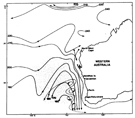 Representation of the major features of the circulation of the southeastern Indian Ocean. Representation of the major features of the circulation of the southeastern Indian Ocean.
Geopotential anomaly contours (full line) after Wyrtki (1961), (dotted) after Andrews (1975, 1977), and the Leeuwin Current modified from Cresswell & Golding (1980, dashed) are surimposed on the known extent of the larval distribution of Panulirus cygnus shown as a shaded area.
Issued from : B.F. Phillips in Oceanogr. Mar. Biol. Ann. Rev., 1981, 19. [p.31, Fig.21].
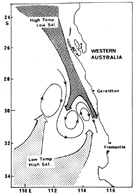 Idealized representation of the two major water types found in the southeastern Indian Ocean (after Kitani, 1977). Idealized representation of the two major water types found in the southeastern Indian Ocean (after Kitani, 1977).
B.F. Phillips in Oceanogr. Mar. Biol. Ann. Rev., 1981, 19. [p.30, Fig.20].
Courants de l'Océan Indien :
Courant équatorial :
Au sud de l'équateur, au niveau du 10° de latitude Sud, le mouvement général des eaux dessine un vaste circuit cyclonique, tout à fait comparable à celui des autres océans.
Le courant Sud-équatorial se dirige de l'Est vers l'Ouest, parallèlement à l'équateur. Ce courant, dont la vitesse est de 20 à 25 milles par jour, ne dépasse jamais l'équateur. Sa limite Nord, qui varie comme celui des alizés du Sud-Est, est en général comprise entre 4 et 10° Sud. Sa limite Sud s'étend en certains points jusqu'au 25ème parallèle (parallèle du Sud de Madagascar). La masse énorme des eaux qu'il transporte, en avançant vers l'Ouest, se trouve contrariée par l'obstacle que représente Madagascar. Elle commence à se diviser près des îles de La Réunion et Maurice : une branche passe au Nord de Madagascar, l'autre au Sud.
Courant du Mozambique :
La branche Nord du courant équatorial, qui contourne le Cap d'Ambre (Madagascar) à une vitesse vers l'Ouest de 1 à 3 nœuds, arrive à la côte d'Afrique à la hauteur du Cap Delgado, situé approximativement sur le parallèle du Cap d'Ambre. Une partie s'infléchit vers le Sud-Ouest et devient le courant du Mozambique, qui longe la côte d'Afrique, et dont le débit et la vitesse diffèrent suivant la saison. Le courant est beaucoup plus régulier et plus fort pendant la mousson du Nord-Est de l'hémisphère Nord (de novembre à janvier, sa vitesse atteint 1 nœud, tandis qu 'elle n'est que d'un demi-nœud de mai à juillet).
Courant des Aiguilles :
La branche Sud du courant équatorial passe au Sud de Madagascar à une vitesse d'un demi-nœud, et va rejoindre, à la hauteur de Natal, le courant du Mozambique. Leur réunion forme le courant des Aiguilles, qui se fait sentir jusqu'à une distance de 120 milles de terre, et qui transporte jusqu'au Cap de Bonne-Espérance des eaux relativement chaudes.
Ce courant des Aiguilles, un des plus violents des courants océaniques, est aussi l'un des plus constants. Le long de la côte du Natal sa vitesse atteint 4 nœuds, parfois 5, et rarement inférieure à 2 nœuds.
Le courant des Aiguilles ne paraît pas présenter une variation annuelle régulière en volume, en force ou en direction. Peut-être est-il un peu moins fort en juillet, au moment où souffle dans le Nord de l'Océan Indien la mousson de Sud-Ouest, et où le courant du Mozambique, qui l'alimente en partie, est plus faible.
Les coups de vent d'Ouest, assez fréquents à ces latitudes, le contrarient parfois, mais il devient plus violent, comme si le barrage momentané, que lui avait opposé le vent, avait accumulé ses eaux, qui se déchargent ensuite. Il crée une mer dangereuse, surtout au bard Sud-Est du Banc des Aiguilles. Sur le banc lui-même, par profondeurs inférieures à 120 mètres, la mer est beaucoup moins forte. Le courant suit plutôt les contours du banc sans les dépasser côté terre. Une faible partie passe sur l'extrémité Sud du banc, ou la contourne, pour rejoindre, au delà du Cap de Bonne-Espérance, le courant de la côte Ouest d'Afrique australe, qui se dirige vers le Nord. Les eaux chaudes atteignent rarement la Baie de la Table (Le Cap), où l'eau est beaucoup plus froide que dans la Baie Simons.
La partie principale du courant des Aiguilles se dirige vers le Sud jusqu'au parallèle de 40° Sud, où elle s'infléchit vers l'Est pour rejoindre le courant de l'Océan Austral, qui vient du Sud-Ouest et de l'Ouest-Sud-Ouest.
La rencontre des eaux chaudes et salées du courant des Aiguilles avec les eaux froides et moins salées du courant de l'Océan Austral crée, entre les parallèles de 37° et 40° Sud, une région de courants variables et de remous, où la température et la salinité varient rapidement q'un point à un autre : des différences de 10°C de température ont été signalées entre points rapprochés. La ligne de réunion des courants est indiquée par un changement de couleur de l'eau.
Contre-courants côtiers :
Le courant du Mozambique et surtout le courant des Aiguilles ne sont nettement dirigés vers le Sud-Ouest qu'à une distance de terre d'au moins 3 milles. Plus près du rivage, il se produit des contre-courants portant vers le Nord-Est et vers l'Est, et parfois à terre. Là où les courants de marée sont importants. Dans le voisinage du Cap des Aiguilles existe un contre-courant portant au Nord (c'est à dire à terre) à une vitesse dépassant parfois 1 nœud.
Courant de l'Océan Indien Austral :
Formé par la rencontre du courant chaud des Aiguilles avec le courant plus froid en provenance de l'Ouest-Sud-Ouest, il se dirige vers l'Est et Est-Nord-Est, sa vitesse moyenne est d'environ 1,5 nœud, des vitesses plus fortes, atteignant 3 nœuds, ont été signalées.
Le courant est plus fort et plus septentrional en été qu'en hiver ; on le rencontre vers le Sud jusqu'à la latitude de 50°. Plus à l'Est, la vitesse diminue ; au voisinage des Kerguelen, ce n'est plus qu'une dérive assez lente, d'une dizaine de milles par jour, qui va rejoindre, au Sud de l'Australie, la dérive de l'Océan Pacifique austral.
Courants au Sud Ouest de l'Australie :
Sur la côte occidentale d'Australie, entre le Cap Leeuwin et la Pointe Cloates, le courant porte généralement au Nord-Ouest, à la vitesse de 1 nœud à 1,5 nœud. Ce courant est profondément modifié par le vent. Pendant l'hiver au voisinage de la terre, il est remplacé par un courant vers le Sud.
Courants sub-équatorial et septentrionaux :
Dans la partie septentrionale de l'Océan Indien, les courants présentent une variation saisonnière remarquable. Le mouvement des eaux suit, dans ses grandes lignes, le mouvement des masses d'air, mouvement commandé par les moussons du Nord-Est pendant l'hiver boréal, du Sud-Ouest pendant l'été boréal.
Pendant l'hiver de l'hémisphère Nord, à l'époque de la mousson du Nord-Est, les courants sont dirigés dans la direction de l'Ouest, aussi bien dans la Mer d'Oman que dans le Golfe du Bengale. Le Sri Lanka est complètement baigné au Nord et au Sud par les eaux de ce courant.
Dans le Golfe du Bengale, à la latitude de Madras, le courant s'infléchit vers le Nord et décrit un circuit dans le sens des aiguilles d'une montre. A la sortie du détroit de Malacca, le courant a une vitesse de 2 à 3 nœuds.
Dans la mer d'Oman, la vitesse du courant vers l'Ouest et le Sud-Ouest n'atteint pas un nœud, elle dépasse 2 nœuds dans le Golfe d'Aden, surtout sur le côte d'Arabie (sur la côte de Somalie, on observe souvent un contre-courant portant vers l'Est, d'une vitesse de 1 nœud). En s'infléchissant vers le Sud le long de la côte des Somalis le courant augmente encore de rapidité (J. Rouch a mesuré 84 milles par jour dans une traversée de Guardafui (Ras Asir) à Zanzibar.
Contre-courant équatorial :
Entre ces courants portant vers l'Ouest et le courant Sud-équatorial, on observe un contre-courant équatorial portant à l'Est, dont la limite Nord est l'équateur et la limite Sud le 6ème parallèle environ. La vitesse de ce contre-courant est très variable, assez faible à son point de départ au voisinage de la côte d'Afrique (1 à 1,5 nœud), vers le milieu de l'Océan Indien, alors que le contre-courant passe entre les Maldives et l'archipel des Chagos, la vitesse peut atteindre 3 nœuds.
Pendant l'été de l'hémisphère Nord, c'est la mousson du Sud-Ouest qui est le vent régulier dans l'Océan Indien septentrional. Les courants changent de direction en même temps que les vents. Dans ces conditions, au lieu de porter à l'Ouest et au Sud-Ouest, ils portent à l'Est et au Nord-Est.
Les plus grandes vitesses du courant de mousson d'été se rencontrent le long de la côte des Somalis et autour de Sri Lanka. Le long de la côte des Somalis, la plus grande vitesse a été de 133 milles par jour (soit plus de 5 nœuds). Cette grande vitesse des courants est due à la vitesse de la mousson du Sud-Ouest qui atteint 12 et même 15 mètres par seconde.
A 150 milles dans le Sud de Socotra, le courant est dévié par les faibles profondeurs (entre l'île de Socotra et le Ras Asir). Sur le parallèle du Ras Hafun, le courant porte vers l'Est jusqu'au méridien de Socotra, puis au Sud Est en conservant une vitesse de 4 nœuds. On a même signalé, à 170 milles au Sud de Socotra, un courant Est-Sud-Est de 7 nœuds. Comme dans ces parages la mousson du Sud-Ouest n'est pas déviée ni sa force diminuée, à la rencontre de la mousson et du courant vers le Sud-Est, il existe une zone où la mer est particulièrement agitée (entre 8° et 11° de latitude Nord et 53° et 58° de longitude Est).
Au voisinage de Sri Lanka, la vitesse du courant ne paraît pas dépasser 3,5 nœuds.
Dans le Golfe d'Aden, on observe le long de la côte d'Afrique un contre-courant dirigé vers l'Ouest, si bien que sur cette côte, en toutes saisons le courant est toujours en sens inverse du vent qui souffle sur le Golfe d'Oman.
Les changements de courants ne sont pas simultanés avec les changements de mousson. Dans l'ensemble, les courants vers le Nord-Est et l'Est durent plus longtemps que les courants vers l'Ouest et le Sud-Ouest.
La côte orientale de Sri Lanka et la péninsule indienne sont reliées par un ensemble d'îles et de récifs coralliens formant le Pont d'Adam, cette topographie permettant d'observer avec précision les changements saisonniers du courant. Entre une de ces îles, l'île Ramesvaran, et la côte indienne, il existe une passe profonde de 3 à 4 mètres et large de 25 à 60 mètres où le courant change de sens avec la mousson, vers le Sud avec la mousson du Nord-Est, vers le Nord avec la mousson du Sud-Ouest. Quand la mousson est bien établie, la vitesse de ce courant atteint 7 nœuds.
Le Golfe Arabe :
Dans le Golfe Arabe, où l'amplitude de la marée est relativement forte et les profondeurs faibles, ce sont les courants de marée qui dominent ; leur vitesse atteint 3 nœuds en plusieurs points. En été, la mousson du Sud-Ouest pousse les eaux à l'intérieur du Golfe ; en hiver, pendant la mousson du Nord-Est, il se produit un mouvement inverse.
Références :
J. Rouch, Traité d'Océanographie physique. Les mouvements de la mer. Vol. 3. Edit. Payot, Paris, 1948.
National Geographic Society, Washington D.C., 1981, pp.228-229
Atlas of Pilot Charts http://msi.nga.mil/NGAPortal/MSI.portal?_nfpb=true&_pageLabel=msi_portal_page_62&pubCode=0003 NATIONAL GEOSPATIAL-INTELLIGENCE AGENCY (USA)
The Red Sea contained 111 species of which the majority are originally from the Indo-Pacific region (Sewell, 1948, p.435). With 280 species this number is still one of the lowest, due in part to the restricted opening into the Indian Ocean, but probably also to the limited number of sampling cruises. Analysis shows that 229 species are shared with the Indian Ocean, and 217 with the Mediterranean. 239 of these relatively cosmopolitan species are also found in several other zones.
Courants en mer Rouge :
En faisant abstraction des courants de marée, sensibles surtout aux extrémités Nord et Sud de la mer Rouge, à savoir dans le Golfe de Suez et dans le détroit de Bab-el-Mandeb, les courants dépendent des moussons de l'Océan Indien.
D'octobre à mars (période de la mousson du Nord-Est) le courant porte au Nord-Nord-Ouest dans le détroit de Bab-el-Mandeb, où il atteint une vitesse de 1 à 2 nœuds, et ce courant peut se faire sentir parfois jusqu'au Nord de la Mer Rouge.
De juin à septembre (période de la mousson du Sud-Ouest) le courant est Sud-Sud-Est du milieu de la mer Rouge jusqu'au détroit de Bab-el-mandeb, où sa vitesse est de 30 à 40 milles par jour. Dans le Nord de la Mer Rouge, on continue souvent à observer dans cette saison un courant vers le Nord-Nord-Ouest.
Références :
J. Rouch, Traité d'Océanographie physique. Les mouvements de la mer. Vol. 3. Edit. Payot, Paris, 1948.
National Geographic Society, Washington D.C., 1981, pp.228-229
Atlas of Pilot Charts http://msi.nga.mil/NGAPortal/MSI.portal?_nfpb=true&_pageLabel=msi_portal_page_62&pubCode=0003 NATIONAL GEOSPATIAL-INTELLIGENCE AGENCY (USA)
Zones: G. of Thailand, Indo-Malay Archipelago (17)  ; China Seas (21) ; China Seas (21) 
|
17 |
21 |
Total species: |
649 (25.3 %) (+ 8 ind.) |
641 (25 %) (+ 6 ind.) |
Calanoida: |
531 |
490 |
other orders |
118 |
151 |
Copepoda have not been intensively studied in the Indo-Malay Archipelago since the work of A. Scott (1909) who recorded 326 species (not including Lichomolgidae). Vervoort (1946) et Wilson (1950) contributed to knowledge of the fauna of this region. In view of the large number of islands of all sizes and the deeps that separate them, the total number of species in this zone has probably been vastly underestimated. 380 species, i.e. 57.9 %, are shared with tropical and subtropical zones in the Pacific.
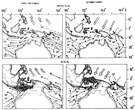 Issued from : A. Fleminger in UNESCO Techn. papers mar. Sci., 1986, 49. [p.89, Fig.5]. Issued from : A. Fleminger in UNESCO Techn. papers mar. Sci., 1986, 49. [p.89, Fig.5].
Sea surface temperature isotherms, °C, surface currents (slender arrows) and Northeast Trade Winds (thick arrows) in eastern Indo-Australian region.
Top two panels show conditions in southern hemisphere winter and summer conditions in the present time and hypothetized for past interglacial stages.
Bottom two panels show conditions thought to prevail during Pleistocene glacial stages. Oblique line shading show areas in which unusually cool (<21°C) surface temperatures may have predominated seasonally and acted as a barrier to the passage of mixed layer stenotherms; land area extended to 200 m isobath to approximately lowered eustatic sea level during glacial stages (modified from Webster & Streten, 1972; Brinton, 1975).
Nota : Dotted shading in the area of Wallacea represents special local conditions that would have lowered surface temperatures on a seasonal basis. Quinn (1971) argues for increased upwelling in equatorial latitudes of the westernmost Pacific during Pleistocene glacial stages. He notes the existence of fossil guano deposits on equatorial islands lying west of the Gilberts Islands, which indicates the past presence of large colonies of sea birds on islands now lacking such colonies.
Presumably during Pleistocene glacial periods, equatorial upwelling in the west Pacific provided the ressources to support the now extinct bird colonies. In general over the past 75000 years, fluctuations in the intensity of the trade winds has been concurrent or preceded fluctuations in the amount of ice stored on continents and wind velocityn of the winter trades intensified during cool climatic stages of the earth and diminished during warm stages (Molina-Cruz, 1977).
Pleistocene glacial stages appear to have persisted for periods of tens of thousands of years.
Bé & Dupless (1976) indicates that the glacial stages persisted for tens of thousands of years several times during the million years of the Pleistocene. For stenothermal species ranging years (1976) show that the half-million –year records for the western Indian Ocean and the quarter-million-year record for te eastern Indian Ocean had cold conditions prevailing for more than half of their respective periods. Van Andel & al. (1967) and Webster & Streten (1972) believe that cool water entered the Timor Sea during Pleistocene glacial stages based on an intensification of the cool, west Australian boundary current an dits more northward penetration. Changes in current intensity during Pleistocene glacial stages have been recorded off South Africa (Hutson, 1980).
In the northern hemisphere during Pleistocene glacial winters, the NE Trades probably intensified sufficiently to induce coastal upwelling off northwest New Guinea and the eastern Moluccas. Webster & Streten (1972) suggest that surface temperatures off northwest New Guinea ranged from 22 to 24°C, while the CLIMAP Project (1976) indicates 25 to 27°C in the southern hemisphere winter for this area. Reducing these values by 3°C, the extent surface temperatures are lowered in upwelling plumes off New Guinea, would depress winter Pleistocene surface temperatures to a range of 19 to 24°C, i .e., well below present-day winter conditions. Assuming that the median, 21.5°C, is close to actual surface temperatures in upwelling plumes of the Pleistocene glacial winter, the northern end of Wallacea would be inhospitable to tropical stenotherms roughly from October to March. In the southern hemisphere's winter, the West Australia Boundary Current would intensify and the SE Trades might cause coastal upwelling along the Sehul shelf. It is reasonable to expect winter surface temperatures of about 20°C in the Timor and Banda Seas (as shown by Webster & Srreten, 1972), rendering the southern end of Wallacea inhospitable to surface-bound stenotherms roughly between April and September.
The hypothetized glacial-stage conditions shown in the lower two panels of figure 5 would enhance C. philippinensis and Rhincalanus nasutus population expansions, while depressing populations of sternothermal pontellids.
Stratigraphic evidence by Bé & Duplessy (1976) indicates that the glacial stages persisted for tens of thousands of years several times during the million years of the Pleistocene. For stenothermal species ranging across Wallacea, each glacial sequence would interrupt their distribution and provide an opportunity for the allopartic subpopulations to diverge.
If Wallacea was a long-term barrier to passage of stenothermal species of the mixed layer, we should expert to see evidence of its vicariant role in speciation patterns of locally distributed species groups. That is, sister species may be expected to have allopatric or parpatric distributions extending from Wallacea.
 Biogeographic bounderies proposed for separating the Oriental and the Australia/New Guinea faunal regions (see George, 1981). Biogeographic bounderies proposed for separating the Oriental and the Australia/New Guinea faunal regions (see George, 1981).
Issued from : A. Fleminger in UNESCO techn. Pap.Mar. Sci., 1986, 49. [p.84, Fig.1].
 Topographic feature of the Kuroshio region (modified from Mogi, 1972). Topographic feature of the Kuroshio region (modified from Mogi, 1972).
Ridges: A, Izu-Ogasawara; B, Mariana; C, Yap; D, Kyushu-Palau; E, Daito, F, Ryukyu.
Basins: 1, Shikoku; 2, West Mariana; 3, Philippines; 4, South China Sea.
Others: I, Okinawa Trough; II Bashi Channel; III, Sakishima Depression; IV, Tokara Strait.
Issued from : J.L Su, B.X. Guan & J.Z. Jiang in Ann. Rev., 1990, 28. [p.13, Fig.2].
 Schematic picture of the Kuroshio Current and its branches in the China Seas: 1, Kuroshio Current; 2, South China Sea Warm Current; 3, Taiwan Warm Current; 4, Yellow Sea Warm Current; 5, Tsushima Current. Schematic picture of the Kuroshio Current and its branches in the China Seas: 1, Kuroshio Current; 2, South China Sea Warm Current; 3, Taiwan Warm Current; 4, Yellow Sea Warm Current; 5, Tsushima Current.
Issued from : J.L Su, B.X. Guan & J.Z. Jiang in Ann. Rev., 1990, 28. [p.37, Fig.22].
 Issued from : M.-C. Jang, S.H. Baek, P.-G. Jang, W.-J. Lee & K. Shin in Ocean and Polar Res., 2012, 34 (1). [p.40, Fig.2]. Issued from : M.-C. Jang, S.H. Baek, P.-G. Jang, W.-J. Lee & K. Shin in Ocean and Polar Res., 2012, 34 (1). [p.40, Fig.2].
Weekly average sea surface temperature (SST) derived from NOAA/AVHRR during periods in February and July 2009 in the Korea Strait.
Sampling stations are marked as circles.
 Issued from : L.-C. Tseng, R. Kumar, H.-U. Dahms, Q.-C. Chen & J.-S. Hwanh in Zool. Studies, 2008, 47 (1). [p.53, Fig.4]. Issued from : L.-C. Tseng, R. Kumar, H.-U. Dahms, Q.-C. Chen & J.-S. Hwanh in Zool. Studies, 2008, 47 (1). [p.53, Fig.4].
Monthly average sea-surface temperatures (SSTs) derived from averaged hourly recordings (AVHRRs) for (A) Aug. 1998, (B) Dec. 1998, (C) Mar. 1999, and (D) May 1999.
Nota: The Taiwan Strait is a relatively shallow (with an average depth of 60 m), 350 km long, and 180 km wide channel between the island of Taiwan and the southeastern Chinese coast, connecting the two marginal seas of the western Pacific, the East China Sea and the South China Sea.
In the Taiwan Strait there is a congruence of 3 different water masses (East China Sea, South China Sea), and the water masses representing the Kuroshio Current of the western North Pacific such hydrographic conditions affect the zooplankton community composition in the Taiwan Strait..
Wind patterns in this region are determined by the typical East Asian monsoon that is from the northeast (NE) during winter (Oct.-Mar.) and from southwest (SW) during summer (May-Aug.).
During the NE monsoon the China Coastal Current with low temperatures, low salinities, and high nutrient levels moves southwards driving zooplankton from the Bohai Sea, the Yellow Sea, and the East China Sea towards the Taiwan Strait.
Throughout the year, the warm, highly saline, and nutrient-poor Kuroshio Branch Current intrudes into the Taiwan Strait through the northern South China Sea and along the coast of southwestern Taiwan. However, during the prevailing NE monsoon period , the southherly flowing China Coastal Current near the Penghu Channel, south of the Changyun Ridge in the southeastern Taiwan Strait.
In spring when the NE monsoon weakens the Kuroshio Branch Current moves northward along the local isobaths into the northern part of the Taiwan Strait. Conversely, under the prevailing winds of the SW monsoon (May-Aug.), the South China Sea Warm Current with intermediate temperatures, salinities, and nutrient levels intrudes into the Taiwan Strait and moves northward together with the Kuroshio Branch Current that transports plankton from the northern South China Sea.
The hydrographic properties of this part (NW Taiwan) of the Taiwan Strait are mainly influenced by the NE and SW monsoons. The influence of cold water masses disappears during summer with increasing strength of the SW monsoon as water masses from the northern part of the South China Sea enter the Taiwan Strait and influence the hydrography around the west coast of Taiwan, and Guangdong and Fujian Provinces, China.
 Issued from : Y.-C. Lan, M.-A. Lee, C.-H. Liao & K.-T. Lee in J. Mar. Sci. Techn., 2009, 17 (1). [p.2, Table 1, Figs. 1, 2]. Issued from : Y.-C. Lan, M.-A. Lee, C.-H. Liao & K.-T. Lee in J. Mar. Sci. Techn., 2009, 17 (1). [p.2, Table 1, Figs. 1, 2].
Copepod community structure of the winter frontal zone induced by the Kuroshio branch current and the China coastal current in the Taiwan Strait.
Nota: Copepods collected with a Bongo plankton net (mesh aperture: 335 µm), towed obliquely.
At each station, temperature and salinity at different depths were obtained by CTD profiler from the sea surface to a depth near the bottom. NOAA satellites provide SST measurements showing the spatial distribution of surface temperature with 1.1 km spatial resolution.
Chen, B (1986) records 345 species in the China Seas from the Bohai Sea and the Yellow Sea at 40° N to the eastern and southern tropical China Seas .
Zhang, W (2007) divides the China Seas into four sub-areas (South China Sea, East China Sea, Yellow Sea and Bohai Sea) ( See the interactive distribution map  ). Concerning the division position of the sub-areas, in China, the line connecting Cheju Island and north bank of Yangtze River is the division line of Yellow Sea and East China Sea. The line connecting Nanao Island of Guangdong Province and Eluanbi of Taiwan Island is the division line of the East China Sea and South China Sea. About the ascription of sea east of Taiwan Island Zhang proposes that this area should be included into South China Sea due to the oceanic water properties. ). Concerning the division position of the sub-areas, in China, the line connecting Cheju Island and north bank of Yangtze River is the division line of Yellow Sea and East China Sea. The line connecting Nanao Island of Guangdong Province and Eluanbi of Taiwan Island is the division line of the East China Sea and South China Sea. About the ascription of sea east of Taiwan Island Zhang proposes that this area should be included into South China Sea due to the oceanic water properties.
The limits, however, are somewhat artificial, not taking into account movement of masses of water in time and space, and some species are so redundant with those of southern Japan (zone 22) and northern Malaysia and west of the Philippines (zone 17).
Courants dans les mers de Chine :
Les courants dans les mers de Chine sont principalement des courants de mousson.
En mousson du Nord-Est ou de Nord, d'octobre à mars, les courants portent vers le Sud et le Sud-Ouest.
En mousson de Sud-Ouest et de Sud, de juin à août, les courants portent au Nord et au Nord-Est.
Pendant les saisons intermédiaires, avril-mai d'une part, septembre et début octobre d'autre part, les courants sont plus irréguliers et variables.
La vitesse de ces courants de mousson peut dépasser 1 nœud, surtout au voisinage des côtes. Elle atteint près de 3 nœuds en mousson de Sud-Ouest dans le Détroit de Taiwan.
Dans la partie orientale de la Mer de Chine septentrionale, entre Taiwan et le Japon, le Kuroshio passe au travers des îles Ryukyu et se fait sentir à l'ouest de ces îles. Sa vitesse atteint 3 nœuds ; ses eaux chaudes et bleu foncé sont nettement différentes des eaux côtières de plusieurs degrés plus froides, de couleur vert jaunâtre, et qui, pendant l'hiver, coulent en sens contraire.
Références :
J. Rouch, Traité d'Océanographie physique. Les mouvements de la mer. Vol. 3. Edit. Payot, Paris, 1948.
National Geographic Society, Washington D.C., 1981
Atlas of Pilot Charts http://msi.nga.mil/NGAPortal/MSI.portal?_nfpb=true&_pageLabel=msi_portal_page_62&pubCode=0003 NATIONAL GEOSPATIAL-INTELLIGENCE AGENCY (USA)
Zones: Japan (22)  ; NW North Pacific (23) ; NW North Pacific (23) 
|
22 |
23 |
Total species: |
711 (27.7 %) (+ 8 ind.) |
368 (14.3 %) (+ 2 ind.) |
Calanoida: |
556 |
305 |
other orders |
155 |
63 |
 Warm and cold currents around Japan and fishing grounds for pelagic fish, such as skipjack, tuna and squid. Warm and cold currents around Japan and fishing grounds for pelagic fish, such as skipjack, tuna and squid.
A schematic expression of horizontal structures of SST, with fishing grounds in and around the WCR (warm-core rings). A-H are the active areas where the WCRs are often produced.
Issued from : T. Sugimoto & H. Tameishi in Deep-Sea Res., 39, suppl. 1, 1992. [p.S186, Fig.1 (b)].
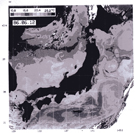 A satellite thermal image of SST around Japan, obtained by the NOAA/AVHRR on 12 June 1986. A satellite thermal image of SST around Japan, obtained by the NOAA/AVHRR on 12 June 1986.
Issued from : T. Sugimoto & H. Tameishi in Deep-Sea Res., 39, suppl. 1, 1992. [p.S186, Fig.1 (a)].
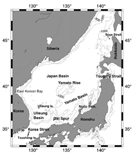 The bottom topography and geographical locations for the Japan/East Sea. The depth contours are at 300 and 1000 m. The bottom topography and geographical locations for the Japan/East Sea. The depth contours are at 300 and 1000 m.
Issued from : D.-K. Lee & P.P. Niiler in Deep-Sea Res. II, 52, 2005. [p.1548, Fig.1].
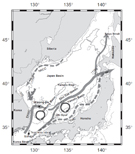 Schematic map of the surface currents in the Japan/East Sea based on Lee and Niiler's (2005) drifter observations. Dotted paths (Tsushima Warm Current [TWC] and North Korean Cold Current [NKCC]) represent the currents observed only during spring and summer, and solid paths (East Korean Warm Current
[EKWC] and East Sea Current) represent the currents observed all the year. Schematic map of the surface currents in the Japan/East Sea based on Lee and Niiler's (2005) drifter observations. Dotted paths (Tsushima Warm Current [TWC] and North Korean Cold Current [NKCC]) represent the currents observed only during spring and summer, and solid paths (East Korean Warm Current
[EKWC] and East Sea Current) represent the currents observed all the year.
Issued from : D.-K. Lee & P.P. Niiler in Deep-Sea Res. I, 57, 2010. [p.1223, Fig.1].
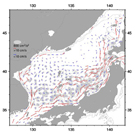 Mean velocity and variance ellipses on 0.5° x 0.5° bins. Red vectors are for the mean speed larger than 10 cm/s and blue vectors are those smaller than 10 cm/s. Mean velocity and variance ellipses on 0.5° x 0.5° bins. Red vectors are for the mean speed larger than 10 cm/s and blue vectors are those smaller than 10 cm/s.
Issued from : D.-K. Lee & P.P. Niiler in Deep-Sea Res. II, 52, 2005. [p.1550, Fig.3].
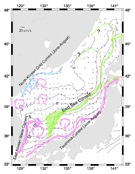 The schematic patterns of surface circulation from
drifter observation drawn on 100 m mean temperature from JMA (2001) [In Oceanographic Normals and Analysis for the period 1971–2000 (CD-ROM). Japan Meteorological Agency, Tokyo]. Red vectors are for mean current larger than 10 cm/s. The schematic patterns of surface circulation from
drifter observation drawn on 100 m mean temperature from JMA (2001) [In Oceanographic Normals and Analysis for the period 1971–2000 (CD-ROM). Japan Meteorological Agency, Tokyo]. Red vectors are for mean current larger than 10 cm/s.
Issued from : D.-K. Lee & P.P. Niiler in Deep-Sea Res. II, 52, 2005. [p.1560, Fig.16].
 Bathymetry of the Japan Sea (a) and numbers show the water depth in meters.In (b) schematic map for sea surface currents (after Senjyu, 1999) with abbrevations: TWC = the Tsushima Warm Current; LC = the Liman Current; EKWC = the East Korean Warm Current; NKCC = the North Korean Cold Current; Bathymetry of the Japan Sea (a) and numbers show the water depth in meters.In (b) schematic map for sea surface currents (after Senjyu, 1999) with abbrevations: TWC = the Tsushima Warm Current; LC = the Liman Current; EKWC = the East Korean Warm Current; NKCC = the North Korean Cold Current;
OI : the Oki Island and NP : Noto Peninsula.
Issued from : A. Morimoto & T. Yanagi in J. Oceanogr., 2001, 57. [p.2, Fig.1].
 Issued from : M.-C. Jang, S.H. Baek, P.-G. Jang, W.-J. Lee & K. Shin in Ocean and Polar Res., 2012, 34 (1). [p.40, Fig.2]. Issued from : M.-C. Jang, S.H. Baek, P.-G. Jang, W.-J. Lee & K. Shin in Ocean and Polar Res., 2012, 34 (1). [p.40, Fig.2].
Weekly average sea surface temperature (SST) derived from NOAA/AVHRR during periods in February and July 2009 in the Korea Strait.
Sampling stations are marked as circles.
 Issued from : L.-C. Tseng, R. Kumar, H.-U. Dahms, Q.-C. Chen & J.-S. Hwanh in Zool. Studies, 2008, 47 (1). [p.53, Fig.4]. Issued from : L.-C. Tseng, R. Kumar, H.-U. Dahms, Q.-C. Chen & J.-S. Hwanh in Zool. Studies, 2008, 47 (1). [p.53, Fig.4].
Monthly average sea-surface temperatures (SSTs) derived from averaged hourly recordings (AVHRRs) for (A) Aug. 1998, (B) Dec. 1998, (C) Mar. 1999, and (D) May 1999.
Nota: The Taiwan Strait is a relatively shallow (with an average depth of 60 m), 350 km long, and 180 km wide channel between the island of Taiwan and the southeastern Chinese coast, connecting the two marginal seas of the western Pacific, the East China Sea and the South China Sea.
In the Taiwan Strait there is a congruence of 3 different water masses (East China Sea, South China Sea), and the water masses representing the Kuroshio Current of the western North Pacific. Such hydrographic conditions affect the zooplankton community composition in the Taiwan Strait.
Wind patterns in this region are determined by the typical East Asian monsoon that is from the northeast (NE) during winter (Oct.-Mar.) and from southwest (SW) during summer (May-Aug.).
During the NE monsoon the China Coastal Current with low temperatures, low salinities, and high nutrient levels moves southwards driving zooplankton from the Bohai Sea, the Yellow Sea, and the East China Sea towards the Taiwan Strait.
Throughout the year, the warm, highly saline, and nutrient-poor Kuroshio Branch Current intrudes into the Taiwan Strait through the northern South China Sea and along the coast of southwestern Taiwan. However, during the prevailing NE monsoon period, the southherly flowing China Coastal Current near the Penghu Channel, south of the Changyun Ridge in the southeastern Taiwan Strait.
In spring when the NE monsoon weakens the Kuroshio Branch Current moves northward along the local isobaths into the northern part of the Taiwan Strait. Conversely, under the prevailing winds of the SW monsoon (May-Aug.), the South China Sea Warm Current with intermediate temperatures, salinities, and nutrient levels intrudes into the Taiwan Strait and moves northward together with the Kuroshio Branch Current that transports plankton from the northern South China Sea.
The hydrographic properties of this part (NW Taiwan) of the Taiwan Strait are mainly influenced by the NE and SW monsoons. The influence of cold water masses disappears during summer with increasing strength of the SW monsoon as water masses from the northern part of the South China Sea enter the Taiwan Strait and influence the fhydrography around the west coast of Taiwan, and Guangdong and Fujian Provinces, China.
Le Courant du Japon ou Kuroshio :
La branche du courant équatorial Nord qui remonte vers le Nord-Ouest atteint Taiwan, et à partir de là, le courant du Japon prend une individualité nette.
A la hauteur de Taiwan, le Kuroshio a une largeur de 100 milles et une vitesse de 1,5 nœud. Plus au Nord, le long des îles Ryukyu, sa largeur diminue jusqu'à une soixantaine de milles ; sa vitesse est alors de 2 à 3 nœuds dans l'axe, de 1 nœud sur les bords. Par 32° Nord, devant l'île Kyushu, le Kuroshio n'a pas une vitesse supérieure à 2 nœuds. Au Cap Moroto Saki, au delà duquel la côte du Japon tourne brusquement au Nord, le courant a une largeur de 50 milles ; sa vitesse, de 2 nœuds en moyenne, peut atteindre parfois 5 nœuds. Le courant s'oriente alors vers l'Est, pour se souder à la dérive vers l'Est du Pacifique Nord.
En hiver, les eaux de surface du Kuroshio ont une température d'environ 24° à la hauteur de Taiwan ; cette température décroît à mesure qu'on s'avance vers le Nord, et n'est plus que de 13°C environ par 35° de latitude. En été, ces températures sont respectivement de 27° et de 18°C environ ; c'est seulement en cette saison que les eaux du Kuroshio sont nettement plus chaudes que les eaux du large. Tout le long de son parcours, le Kuroshio a une salinité de 34,5. Ses eaux sont bleu foncé (nom qui en japonais veut dire courant noir).
Courant de la Mer du Japon :
Une branche du Kuroshio pénètre dans la Mer du Japon par le détroit de Corée (appelé aussi Courant de Tu Sima) ; il a une vitesse moyenne de 1,5 nœud, plus fort en été, où sa vitesse dépasse 2,5 nœuds. Le courant s'oriente vers le Nord-Est dans la Mer du Japon, longe les côtes japonaises à une vitesse de 10 milles par jour, et atteint le Golfe de Tartarie. Sur la côte d'Asie, il existe un courant vers le Sud, plus marqué en hiver qu'en été.
Dans les détroits de Tsugaru et de La Pérouse, le courant porte à l'Est, souvent à des vitesses très grandes, atteignant 6 à 7 nœuds.
Courant Oyashio :
Un courant froid venant de la Mer de Béring, l'Oyashio, descend à une vitesse de plus d'un nœud le long des Kouriles et jusqu'au rivage de Honshu, où il crée, par contraste avec le Kuroshio qui s'étale plus au large, une sorte de zone de contact. Ce courant n'atteint jamais les abords du Golfe de Tokyo, les anomalies négatives de température qu'on y observe en hiver sont dues à des remontées d'eaux froides, ou à l'influence des basses températures qui règnent alors au Japon.
Références :
J. Rouch, Traité d'Océanographie physique. Les mouvements de la mer. Vol. 3. Edit. Payot, Paris, 1948.
National Geographic Society, Washington D.C., 1981
Atlas of Pilot Charts http://msi.nga.mil/NGAPortal/MSI.portal?_nfpb=true&_pageLabel=msi_portal_page_62&pubCode=0003 NATIONAL GEOSPATIAL-INTELLIGENCE AGENCY (USA)
 Schematic diagram for the transport of the fresh Oyashio water (black arrowed curves) and old NPIW (North Pacific Intermediate Water) (gray arrowed curves) in the salinity minimum layer. Schematic diagram for the transport of the fresh Oyashio water (black arrowed curves) and old NPIW (North Pacific Intermediate Water) (gray arrowed curves) in the salinity minimum layer.
The movement and mixing of these waters were strongly related to the small and meso scales features in the MWR (Mixed Water Region) such as the First Branch of the Oyashio (FBO), the Second Branch of the Oyashio (SBO), the inner cold belt (ICB), warm core ring (WCR) and warm streamer (WS).
Old NPIW transported by the Kuroshio Extension (KE) strongly mixed with the fresh Oyashio water extended from the first branch of the Oyashio (FBO) in and around WS.
The fresh Oyashio water extended from SBO was transported eastward along the northern edge of KE beyond 150°E with a form of rather narrow band.
The subsurface intrusion at the northern edge of KE ejected lens-like Oyashio waters southward across KE axis and split northwarde into a warm core ring probably by the interaction of KE and WCR, suggesting the processes of freshening NPIW in the offshore MWR and the Kuroshio recirculation region.
The aim is to understand the actual formation process of the North Pacific Intermediate Water examined on the basis of a synoptic CTD observation carried out in May-June 1992.
Issued from : K. Okuda, I. Yasuda, Hiroe Y. & Y. Shipmizu in J. Oceanogr., 2001, 57. [p.138, Fig.10].
233 species are common to Japan and the sub-Arctic zone (i.e. 32.5 %), although the dominant influence on Japanese planktonic fauna is generally tropical.
 Diagram of the relationship of the Oyashio Current to other currents in the northwest Pacific Ocean (Modified from Qiu, 2001).
Diagram of the relationship of the Oyashio Current to other currents in the northwest Pacific Ocean (Modified from Qiu, 2001).
Issued from : Y. Sakurai in Deep-Sea Research II, 2007, 54; [p.2527, Fig.1].
Of 171 species common to the NW and NE Pacific sub-Arctic zones, 11 are known only in these two zones.
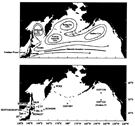 Schematic current systems (top, redrawn from Favorite & al., 1976) and sampling stations in the subarctic Pacific Ocean and neighboring waters (bottom). Schematic current systems (top, redrawn from Favorite & al., 1976) and sampling stations in the subarctic Pacific Ocean and neighboring waters (bottom).
Issued from : T. Kobari & T. Ikeda in J. Plankton Res., 2001, 23 (3). [p.288, Fig.1].
 The Bering Sea. Isobaths shown are 50 m (between inner and middle domains), 100 m (between middle and outer domains) and 200 m (between outer domain and slope/basdin. Schematic of major currents based on Stabeno & al. (1999). AC: Anadyr Current; ACC: Alaska Coastal Current; ANSC: Aleutian North Slope Current; BS: Bering Strait. The Bering Sea. Isobaths shown are 50 m (between inner and middle domains), 100 m (between middle and outer domains) and 200 m (between outer domain and slope/basdin. Schematic of major currents based on Stabeno & al. (1999). AC: Anadyr Current; ACC: Alaska Coastal Current; ANSC: Aleutian North Slope Current; BS: Bering Strait.
Issued from : K. Aydin & F. Mueter in Deep-Sea Research II, 2007, 54. [p.2502, Fig.1].
 Map of the northern Bering Sea and Chukchi. Map of the northern Bering Sea and Chukchi.
The box marks the survey area of the hydrographic conditions (temperature, salinity and chlorophyll) and Gray whale counts during June to September. The arrows show the prevailing current regime.
Issued from : B.A. Bluhm, K.O. Coyle, B. Konar & R. Highsmith in Deep-Sea Resaeach, 2007, 54. [p.2921, Fig.1]. .
 Average summer season distributions of upper ocean chlorophyll concentration (upper panel) and zooplankton biomass (lower panel) in the subarctic Pacific, overlaid with circulation pattern. Figure courtesy of K. Tadokoro, modified by colorization and addition of circulation streamlines from Sugimoto and Tadokoro, 1997. Average summer season distributions of upper ocean chlorophyll concentration (upper panel) and zooplankton biomass (lower panel) in the subarctic Pacific, overlaid with circulation pattern. Figure courtesy of K. Tadokoro, modified by colorization and addition of circulation streamlines from Sugimoto and Tadokoro, 1997.
Issued from : Mackas D.L. & Tsuda A., 1999. - Mesozooplankton in the eastern and western subarctic Pacific: community structure, seasonal life histories, and interannual variability. Progress in Oceanography, 43. [p.352, Fig.8].
 Map of the subarctic Pacific showing place names referred to in this paper (adapted from Brodeur et al., 1996). Map of the subarctic Pacific showing place names referred to in this paper (adapted from Brodeur et al., 1996).
Issued from : Mackas D.L. & Tsuda A., 1999. - Mesozooplankton in the eastern and western subarctic Pacific: community structure, seasonal life histories, and interannual variability. Progress in Oceanography, 43. [p.337, Fig.1].
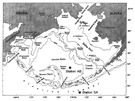 Major topographic features of the Bering Sea and Aleutian Islands. Contours of 100, 200, 1000 and 3500 m are shown. (Basic map from U.S. GLOBEC 1996). Major topographic features of the Bering Sea and Aleutian Islands. Contours of 100, 200, 1000 and 3500 m are shown. (Basic map from U.S. GLOBEC 1996).
Issued from : Takahashi K., 1998. - The Bering and Okhotsk Seas: modern and past
paleoceanographic changes and gateway impact. Journal of Asian Earth Sciences, 16 (1). [p.50, Fig.1].
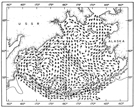 A map showing surface currents in the Bering Sea (from Arsen'ev 1967). A map showing surface currents in the Bering Sea (from Arsen'ev 1967).
Issued from : Takahashi K., 1998. - The Bering and Okhotsk Seas: modern and past
paleoceanographic changes and gateway impact. Journal of Asian Earth Sciences, 16 (1). [p.51, Fig.2].
 Surface thermal fronts of the Okhotsk Sea from Pathfinder data, 1985–1996. Surface thermal fronts of the Okhotsk Sea from Pathfinder data, 1985–1996.
Issued from : Belkin I.M. & Cornillon P.C., 2004. - Surface Thermal Fronts of the Okhotsk Sea. Physical Oceanography, 2 (1-2). [p.9, Fig.1].
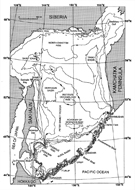 Major topographic features of the Okhotsk Sea and Kuril Islands. Contours of 100, 200, 500, 1000, 2000, 2500
and 3000 m are shown (modified from Gnibidenko and Khvedchuk 1982). Major topographic features of the Okhotsk Sea and Kuril Islands. Contours of 100, 200, 500, 1000, 2000, 2500
and 3000 m are shown (modified from Gnibidenko and Khvedchuk 1982).
Issued from : Takahashi K., 1998. - The Bering and Okhotsk Seas: modern and past
paleoceanographic changes and gateway impact. Journal of Asian Earth Sciences, 16 (1). [p.52, Fig.3].
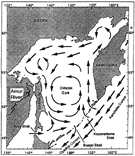 A map sho wing surface currents in the Okhotsk Sea and adjacent regions. Note that a part of the Kamchatka
Current enters into the Okhotsk Sea and a part of the Okhotsk Gyre water exits from the Sea to the Paci®c to form the Oyashio Current just south of the Kuril Islands. The Okhotsk Sea circulation is compiled by R. Tiedemann, employing data obtained by Dodimead et al. (1963), Sancetta (1981), and Talley (1991). A map sho wing surface currents in the Okhotsk Sea and adjacent regions. Note that a part of the Kamchatka
Current enters into the Okhotsk Sea and a part of the Okhotsk Gyre water exits from the Sea to the Paci®c to form the Oyashio Current just south of the Kuril Islands. The Okhotsk Sea circulation is compiled by R. Tiedemann, employing data obtained by Dodimead et al. (1963), Sancetta (1981), and Talley (1991).
Issued from : Takahashi K., 1998. - The Bering and Okhotsk Seas: modern and past
paleoceanographic changes and gateway impact. Journal of Asian Earth Sciences, 16 (1). [p.53, Fig.4].
Courant du Kamtchatka :
Ce courant froid en provenance de la mer de Béring s'écoule le long de la côte Est de la presqu'île du Kamtchatka et des îles Kouriles jusqu'à Hokkaido où il se fond avec l'Oyashio.
Courants de la Mer d'Okhotsk :
Le mouvement général des courants est dans le sens anticyclonique, ceux-ci suivant les côtes.
Sur la côte Nord, on trouve un courant vers l'Ouest ; sur la côte Ouest et auprès de l'île Sakhaline, un courant vers le Sud ; le long de la côte du Kamtchatka, un courant vers le Nord. Les courants vers le Sud sont dans l'ensemble prépondérants ; ils sont faibles, atteignant à peine une vitesse d'un demi nœud, et souvent profondément modifiés par les courants de marée, dont la composante diurne a une forte amplitude : à l'entrée du golfe de Penjina, ces courants de marée atteignent des vitesses de 6 à 7 nœuds. Dans les chenaux qui séparent les îles Kouriles, les courants, fortement influencés par les marées, sont très rapides (des vitesses supérieures à 6 nœuds ont souvent été observées).
D'une façon générale, les courants portent vers le Sud et apportent les eaux froides de la Mer d'Okhotsk à l'Oyashio.
Références :
J. Rouch, Traité d'Océanographie physique. Les mouvements de la mer. Vol. 3. Edit. Payot, Paris, 1948.
National Geographic Society, Washington D.C., 1981
Atlas of Pilot Charts http://msi.nga.mil/NGAPortal/MSI.portal?_nfpb=true&_pageLabel=msi_portal_page_62&pubCode=0003 NATIONAL GEOSPATIAL-INTELLIGENCE AGENCY (USA)
Zones: North East Pacific(24)  ; California (25) ; California (25) 
|
24 |
25 |
Total species: |
298 (11.6 %) (+ 1 ind.) |
458 (17.9 %) (+ 1 ind.) |
Calanoida: |
231 |
360 |
other orders |
67 |
98 |
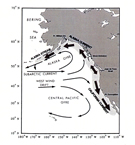 Map of the NE Pacific (adapted from Ware and McFarlane, 1989) showing location of the shelf-slope-offshore transition region (shaded area) and annual-averaged large-scale current patterns (arrows). The coastal transition region includes both the NE Pacific alongshore boundary current systems: the equatorward/upwelling California Current and the poleward/downwelling Alaska Current/Alaska Coastal Current. Although not shown in the annual averages, the boundary currents undergo seasonal variability in speed and direction (generally more poleward/less equatorward in winter, more equatorward/less poleward in summer), and both produce strong mesoscale cross-shore motion in the form of meanders, eddies and filaments. Map of the NE Pacific (adapted from Ware and McFarlane, 1989) showing location of the shelf-slope-offshore transition region (shaded area) and annual-averaged large-scale current patterns (arrows). The coastal transition region includes both the NE Pacific alongshore boundary current systems: the equatorward/upwelling California Current and the poleward/downwelling Alaska Current/Alaska Coastal Current. Although not shown in the annual averages, the boundary currents undergo seasonal variability in speed and direction (generally more poleward/less equatorward in winter, more equatorward/less poleward in summer), and both produce strong mesoscale cross-shore motion in the form of meanders, eddies and filaments.
Issued from : Mackas D.L. & Coyle K.O., 2005. - Shelf-offshore exchanges processes, and their effects on mesozooplankton biomass and community composition patterns in the northeast Pacific. Deep-Sea Res. II , 52. [p.708, Fig.1].
 Map of the study area showing bathymetry and approximate summer circulation pattern. Solid arrows indicate near-bottom currents, open arrows show upper layer currents. Map of the study area showing bathymetry and approximate summer circulation pattern. Solid arrows indicate near-bottom currents, open arrows show upper layer currents.
Issued from : Mackas D.L. & Sefton H.A., 1982. - Plankton species assemblages off southern Vancouver Island: Geographic pattern and temporal variability. Journal of Marine Resarch, 40 (4). [p.1176, Fig.1].
The north-eastern Pacific (Aleutians , Gulf of Alaska , "P" Station, British Colombia), sub-Arctic in character, is one of the least diversified regions.
It is, however, also one of the least explored (Wilson, 1942 a, 1950; Davis, 1949) with the exception of "P Station" (50° N, 145° W). In this region, 175 species are shared with the Californian zone (i.e. 58.5 %) and 171 species with the North-west region (i.e. 57.2 %). These percentages confirm the uniqueness of the sub-Arctic community.
The communities of the Californian and Japanese regions have been united in the northern sub-tropical zone (Van der Spoel & Heyman, 1983, p.12, fig.11), which would seem to confirm the percentages of species common to the two zones: 333 common species (i.e. 72.5 %).
Courant de l'Alaska :
La dérive du Pacifique Nord, lorsqu'elle atteint, vers le 50° degré de latitude, les rivages américains, se divise en deux courants. Au Nord, le courant de l'Alaska suit vers le Nord-Ouest la côte de la Colombie Britannique et de l'Alaska à une vitesse qui peut atteindre 1,5 nœud. Il contourne le Golfe d'Alaska, dessinant un circuit dans le sens inverse des aiguilles d'une montre, se renforce à l'Ouest de l'île Kodiak jusqu'aux îles Aléoutiennes les plus orientales. Ces eaux sont plus chaudes que celles plus Sud.
Courant de Californie :
La deuxième branche de la dérive du Pacifique Nord suit vers le Sud la côte de l'Amérique depuis la latitude de 50° Nord jusqu'à la presqu'île de Basse Californie par 23° Nord. C'est un courant froid, large de 200 à 300 milles, dont la vitesse est de ¾ de nœud. Accompagné de remontées d'eaux froides (upwelling), il donne, à l'entrée de la Baie de San Francisco, des températures de la mer qui ne dépassent pas 15°C en plein été.
Le courant suit la direction de la côte vers le Sud-Sud-Est, mais commence à s'incliner vers le Sud et le Sud-Ouest dès la hauteur de Monterey. Il règne alors le long de la côte, surtout en hiver, un contre-courant ou Courant de Davidson.
A la hauteur du Cap San Lucas, extrémité méridionale de la Basse Californie, le courant de Californie est orienté vers le Sud-Ouest et rejoint les eaux du courant équatorial.
Références :
J. Rouch, Traité d'Océanographie physique. Les mouvements de la mer. Vol. 3. Edit. Payot, Paris, 1948.
National Geographic Society, Washington D.C., 1981
Atlas of Pilot Charts http://msi.nga.mil/NGAPortal/MSI.portal?_nfpb=true&_pageLabel=msi_portal_page_62&pubCode=0003 NATIONAL GEOSPATIAL-INTELLIGENCE AGENCY (USA)
Zones: Central Tropical Pacific (19)  ; Eastern Tropical Pacific (20) ; Eastern Tropical Pacific (20) 
|
19 |
20 |
Total species: |
541 (21.1 %) (+ 9 ind.) |
514 (20 %) (+ 3 ind.) |
Calanoida: |
433 |
401 |
other orders |
108 |
113 |
352 species species are common to the two regions (i.e. 64.1 % and 68 % respectively).
Zone 19 :
Dans la région comprise entre les tropiques et soumise aux alizés, les eaux de l'Océan Pacifique Nord ont un mouvement général vers l'Ouest. Il se forme ainsi deux courants équatoriaux.
Le courant équatorial du Nord est compris entre les parallèles 20°-25° Nord et 8°-9° Nord. Le courant équatorial Sud entre les parallèles 4°-5 °Nord et 20°-25° Sud.
Les îles Hawaï sont comprises dans le courant équatorial du Nord et Tahiti dans le courant équatorial du Sud, à sa limite Sud.
La vitesse de ces courants équatoriaux varie entre un demi nœud et 3 nœuds ; elle est plus faible à mesure qu'on s'éloigne de l'équateur. Le courant équatorial Sud a une vitesse plus forte que le courant équatorial Nord.
Les deux courants équatoriaux ne se réunissent pas, comme ils le font dans l'Atlantique, mais sont séparés sur tout leur parcours par un contre-courant vers l'Est qui se fait sentir depuis le Sud des Philippines jusqu'à la côte américaine, (en été de l'hémisphère Nord) sur une bande de 300 milles de largeur, entre 4°-5° de latitude Nord et 8°-9° de latitude Nord (en été de l'hémisphère Nord), en hiver sur une bande beaucoup plus étroite, surtout au milieu de l'Océan Pacifique, et plus méridionale. La vitesse du contre-courant est plus faible que celle des courants équatoriaux, elle ne dépasse pas 2 nœuds. Pendant les mois d'hiver de l'hémisphère Nord, il arrive qu'elle soit à peine sensible. Le contre-courant assure, pour une part plus importante que dans l'Atlantique, le retour vers l'Est des eaux transportées par les courants équatoriaux.
La présence d'archipels sur le parcours des courants équatoriaux apporte des modifications, mais toutes locales, à ces courants, qui sont alors divisés et parfois fortement déviés. Des remontées d'eaux profondes (upwelling) se traduisent par une baisse de la température superficielle.
Dans la partie orientale de l'Océan Pacifique, entre les Galápagos et le Golfe de Panama, région où l'alizé n'est pas encore bien établi et où règnent des moussons et des vents variables, la circulation marine est très confuse. Dans l'ensemble, on trouve des eaux stagnantes, qui prennent sans doute peu de part à la circulation générale, et dont la température est souvent très élevée.
En arrivant au voisinage des Philippines, par 10° de latitude Nord environ, le courant équatorial du Nord se divise en deux branches ; l'une va vers le Nord-Ouest se joindre au courant du Japon, et l'autre, orientée vers le Sud, longe la côte orientale de Mindanao à une vitesse de 2 nœuds, puis va se joindre aux eaux du contre-courant équatorial.
La dérive du Pacifique Nord :
La branche principale du Kuroshio qui, vers les latitudes de 35° à 40° Nord, se dirige vers l'Est, diminue rapidement de vitesse à mesure qu'elle s'éloigne du Japon. Ses limites deviennent incertaines aussi bien vers le Nord que vers le Sud. Il ne s'agit plus d'un véritable courant, mais d'une dérive, qui à partir du 180° de longitude, ne dépasse pas une vitesse de 12 milles par jour.
Au moment où le Kuroshio se confond avec la dérive plus lente due à l'impulsion des vents d'Ouest, le Kuroshio est beaucoup moins large, moins profond et dans l'ensemble moins chaud. Du point où le Kuroshio se confond avec la dérive du Pacifique Nord à la côte occidentale de l'Amérique, la distance est de 3500 milles ; ainsi l'influence thermique du Kuroshio sur les rivages nord du Pacifique est très atténuée, mais cependant non négligeable, les régions côtières du Sud de l'Alaska, par des latitudes de 60°, ont en hiver des températures à peine inférieures à 0°C, tandis qu'à la même latitude les régions côtières du Kamtchatka ont des températures de – 15° à – 20°C.
Dérive des eaux du Pacifique Sud :
Entre les parallèles de 40° et de 50° Sud, sous l'influence des vents d'Ouest très fréquents à ces latitudes, on observe, sinon un véritable courant, mais une dérive portant vers l'Est jusqu'aux côtes du Chili. Sa vitesse est très faible, de l'ordre de quelques milles par jour ; elle est plus forte à l'Ouest du 120° méridien de longitude Ouest, surtout pendant l'hiver de l'hémisphère austral, où des vitesses de 1 nœud ont été observées.
Les limites de cette dérive sont indiquées par les lignes de convergence subpolaire vers 55° Sud et subtropicale vers 35° Sud. La partie Sud de la dérive est plutôt dirigée vers le Sud-Est, la partie Nord vers le Nord-Est.
Références :
J. Rouch, Traité d'Océanographie physique. Les mouvements de la mer. Vol. 3. Edit. Payot, Paris, 1948.
National Geographic Society, Washington D.C., 1981
Atlas of Pilot Charts http://msi.nga.mil/NGAPortal/MSI.portal?_nfpb=true&_pageLabel=msi_portal_page_62&pubCode=0003 NATIONAL GEOSPATIAL-INTELLIGENCE AGENCY (USA)
Zones: E. Australia - New Zealand (18)  ; Chile (sensu lato) (26) ; Chile (sensu lato) (26) 
|
18 |
26 |
Total species: |
534 (20.8 %) (+ 15 ind.) |
436 (17 %) (+ 1 ind.) |
Calanoida: |
400 |
357 |
other orders |
134 |
79 |
 Major currents and circulation patterns around Australia. Major currents and circulation patterns around Australia.
The continent is bounded by the pacific ocean to the east, the indian Ocean to the west and the Southern Ocean to the south.
Issued from : E.S. Poloczanska & al. in Oceanography and Marine Biology: An Annual Review, 2007, 45. [p.409, Fig.2].
Figure courtesy of S. Condie/CSIRO.
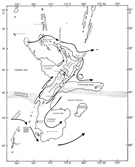 Major bathymetric features of the New Zealand region, surface currents, place names, and topographic features. Major bathymetric features of the New Zealand region, surface currents, place names, and topographic features.
Issued from : Bradford J.M., Roberts P.E., 1978. - Distribution of reactive phosphorus and plankton in relation to upwelling and surface circulation around New Zealand. New Zealand Journal of Marine and Freshwater Research, 12 (1): [p.3, Fig.1].
388 species are common to the Indian Ocean and the E. Australia - New Zealand zone.
Courants d'Australie :
A la hauteur des îles Samoa, le courant équatorial du Sud paraît se diviser en deux branches : l'une continue vers l'Ouest jusqu'à la Nouvelle-Guinée où les courants sont très influencés par la mousson. Pendant l'été de l'hémisphère Nord, un courant assez fort est dirigé vers l'Ouest et le Nord-Ouest, tandis qu'en hiver on observe un courant faible dirigé vers l'Est.
Entre la Nouvelle-Guinée, les îles Salomon, l'Australie et la Nouvelle-Calédonie, les courants sont confus, faibles et variables suivant les saisons. C'est ainsi que dans de Détroit de Torres, en décembre, janvier et février, le courant est dirigé vers l'Est ; il est dirigé vers l'Ouest pendant le reste de l'année. Ce courant peut être rapide lorsque le vent est fort et souffle dans la même direction. De même sur la côte australienne au Nord de Brisbane, on observe en hiver (de l'hémisphère Nord) un courant vers le Sud-Est, en été, un courant vers le Nord-Ouest.
La deuxième branche du courant équatorial, après avoir traversé l'Archipel des Fidji, passe au Sud de la Nouvelle-Calédonie, atteint la côte australienne à la hauteur de Brisbane. Elle forme alors le Courant australien proprement dit, qui longe la côte à une distance comprise entre 20 et 60 milles, sans atteindre vers le large les parages des récifs Middleton et Elisabeth, no l'île Lord Howe. Le courant australien porte vers le Sud à une vitesse de 0,5 à 3 nœuds, pouvant atteindre par place 4 nœuds. A toucher le rivage, il existe souvent un contre-courant vers le Nord.
Le courant australien s'oriente vers le Sud-Est au large de Sydney, et entre l'Australie et la Nouvelle-Zélande un vaste circuit se dessine en sens inverse des aiguilles d'une montre.
Références :
J. Rouch, Traité d'Océanographie physique. Les mouvements de la mer. Vol. 3. Edit. Payot, Paris, 1948.
National Geographic Society, Washington D.C., 1981
Atlas of Pilot Charts http://msi.nga.mil/NGAPortal/MSI.portal?_nfpb=true&_pageLabel=msi_portal_page_62&pubCode=0003 NATIONAL GEOSPATIAL-INTELLIGENCE AGENCY (USA)
254 species are common to the two southern Pacific zones (i.e.
46.3 % and
58.1 % respectively).
Le Courant du Pérou ou de Humboldt :
La dérive du Pacifique Sud en arrivant près des côtes du Chili se divise en deux branches, vers le 50ème degré de latitude Sud.
La première, connue sous le nom de Courant du Cap Horn entraîne autour de la Terre de Feu à la vitesse de 1 nœud des eaux dont la température est plus élevée que celle du Courant des Falklands à la même latitude.
La deuxième branche, Courant du Pérou ou de Humboldt, coule vers le Nord. On l'observe surtout à partir de Valdivia (40° Sud) jusqu'au Cap Blanco (4°30'S).
Le courant du Pérou n'a qu'une largeur moyenne de 100 à 150 milles. Sa vitesse plus forte sur les côtes du Pérou que sur celles du Chili, dépasse à peine en moyenne un demi nœud. Il est surtout reconnaissable à sa basse température, 15° à 19°, inférieure de plusieurs degrés à la température de surface observée au large à la même latitude, et inférieure parfois d'une dizaine de degrés à la température de l'air au niveau de la mer. Il est également particulièrement riche en phosphates et en nitrates.
Humboldt attribuait ces basses températures à un courant froid venu des régions antarctiques. Ces basses températures des eaux de surface sont attribuées à une remontée des eaux profondes (upwelling) le long des côtes aux pentes abruptes. Les mesures de salinité faites par Sverdrup (1930) montrent que les eaux ne proviennent pas des couches très profondes, mais ne dépassent pas 300 mètres.
Les eaux du courant du Pérou sont moins salées que les eaux du large, et s'en distinguent aussi par leur richesse en phytoplancton qui leur confère une couleur verte, contrastant avec le bleu indigo du large.
Le Courant du Pérou est sujet à des variations importantes qui le rapprochent ou l'écartent de la côte. Dans sa partie Nord ses limites sont variables. Un courant vers le Sud, appelé El Niño, qui se manifeste au Nord du Cap Blanco, surtout au cœur de l'été austral (vers la Noël), descend parfois jusqu'à 12° ou 15° de latitude Sud, faisant disparaître les eaux froides côtières, et changeant pour quelques semaines le climat sec du littoral en un climat pluvieux. Lorsque ce phénomène se produit, cette arrivée des eaux chaudes venant de l'Ouest fait momentanément disparaître ou rejette vers le large le Courant de Humboldt.
Références :
J. Rouch, Traité d'Océanographie physique. Les mouvements de la mer. Vol. 3. Edit. Payot, Paris, 1948.
National Geographic Society, Washington D.C., 1981
Atlas of Pilot Charts http://msi.nga.mil/NGAPortal/MSI.portal?_nfpb=true&_pageLabel=msi_portal_page_62&pubCode=0003 NATIONAL GEOSPATIAL-INTELLIGENCE AGENCY (USA)
Zones: South Africa (E & W), Namibia (5)  ; Gulf of Guinea (sensu lato) (6) ; Gulf of Guinea (sensu lato) (6) 
|
5 |
6 |
Total species: |
288 (11.2 %) (+ 3 ind.) |
371 (14.5 %) (+ 2 ind.) |
Calanoida: |
235 |
289 |
other orders |
53 |
82 |
Of the "endemic" to South Africa , 9 species are on the Atlantic side and 2 in the Indian Ocean (Acartia (Acartia) longisetosa, Acartia (Acartia) nana, Centropages natalensis, Centropages tenuicornis, Diaixis centrura).
 A conceptual diagram of the circulation of intermediate water in the eastern South Atlantic and around southern Africa (adapted from Boebel et al., 1998 and based on the work of Shannon and Nelson, 1996; Reid, 1989; and others). AB refers to the Agulhas Bank, and AP to the Agulhas Plateau.
A conceptual diagram of the circulation of intermediate water in the eastern South Atlantic and around southern Africa (adapted from Boebel et al., 1998 and based on the work of Shannon and Nelson, 1996; Reid, 1989; and others). AB refers to the Agulhas Bank, and AP to the Agulhas Plateau.
Issued from : Richardson P.L., Lutjeharms J.R.E. & Boebel O., 2003. - Introduction to the "Inter-ocean exchange around southern Africa". Deep Sea Research II, 50 (1): [p.5, Fig.2].
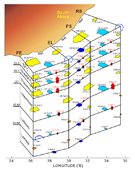 Inverse model mass transport (in Sv) and standard errors for the Agulhas Current system for
the LADCP experiment.
Inverse model mass transport (in Sv) and standard errors for the Agulhas Current system for
the LADCP experiment.
Net mass transport values are displayed on the top, and each individual layer
displays the mass transport associated with it. Red arrows represent diapycnal transports, and blue,
yellow, and orange arrows represent isopycnal transports. Small circular arrows indicate the location of
some of the sampled eddies. PE refers to Port Elizabeth (36°S). EL refers to East London (34°S). PS refers to Port Shepstone (32°S). RB refers to Richards Bay (30°S).
Issued from : Casal T.G.D., Beal L.M., Lumpkin R. & Johns W.E., 2009. - Structure and downstream evolution of the Agulhas Current system during a quasi-synoptic survey in February–March 2003. Journal of Geophysical Research, 114 (C03001): [p.6, Fig.2].
 Physical oceanography during the survey. (a) Temperature at 7 m; (b) salinity at 7 m; (c) mean temperature; (d) mean salinity; (e) integrated chlorophyll a; and (f) mean oxygen. Means and integration are over the water column. Visualization performed in Ocean Data View software (Schlitzer, 2008).
Physical oceanography during the survey. (a) Temperature at 7 m; (b) salinity at 7 m; (c) mean temperature; (d) mean salinity; (e) integrated chlorophyll a; and (f) mean oxygen. Means and integration are over the water column. Visualization performed in Ocean Data View software (Schlitzer, 2008).
Issued from : Lebourges-Dhaussy A., Coetzee J., Hutchings L., Roudaut G. & Nieuwenhuys C., 2009. - Zooplankton spatial distribution along the South African coast studied by multifrequency acoustics, and its relationships with environmental parameters and anchovy distribution. ICES Journal of Marine Science, 66. [p.1057, Fig.2].
 Horizontal distribution of the global zooplankton. (a) Mean biovolume (mm3 m-3); (b) integrated biovolume (mm3 m-2).
Horizontal distribution of the global zooplankton. (a) Mean biovolume (mm3 m-3); (b) integrated biovolume (mm3 m-2).
Issued from : Lebourges-Dhaussy A., Coetzee J., Hutchings L., Roudaut G. & Nieuwenhuys C., 2009. - Zooplankton spatial distribution along the South African coast studied by multifrequency acoustics, and its relationships with environmental parameters and anchovy distribution. ICES Journal of Marine Science, 66. [p.1058, Fig.4].
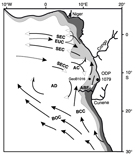 Atlantic currents west of Africa.
Atlantic currents west of Africa.
AC = Angola Current, ABF = Angola Benguela Front, BCC = Benguela Coastal Current, BOC = Benguela Oceanic Current, SECC = South Equatorial Counter Current, SEC = South Equatorial Current, EUC = Equatorial Undercurrent
Issued from : Hogan C., 2012. - Angola-Benguela Front. Retrieved from http://www.eoearth.org/view/article/150063
Zones : Central South Atlantic (12)  ; Brazil-Argentina (SW Atlantic) (13) ; Brazil-Argentina (SW Atlantic) (13) 
|
12 |
13 |
Total species: |
337 (13.1 %) (+ 3 ind.) |
397 (15.5 %) (+ 3 ind.) |
Calanoida: |
291 |
278 |
other orders |
46 |
119 |
183 species
are common to the two zones. It is important to note that most of our knowledge of the diversity of Copepoda in the central South Atlantic comes from very old studies (e.g. Wolfenden, 1911).
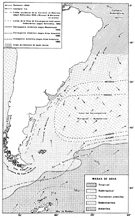 Hydrology from Southwest Atlantic Ocean.
Hydrology from Southwest Atlantic Ocean.
Issued from : E. Boltovskoy in Atlas del Zooplancton del Atlàntico sudoccidental, 1981, ed. D. Boltovskoy, Publ. special des INIPED, Mar del Plata, Argentina. [p.230, Fig.131].
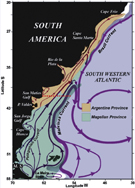 Schematic ocean circulation of the southwestern South Atlantic (modified from Matano et al., 2010) and continental shelf biogeographic provinces (background shading, modified from Balech and Ehrlich (2008) and Boschi (2000)).
Schematic ocean circulation of the southwestern South Atlantic (modified from Matano et al., 2010) and continental shelf biogeographic provinces (background shading, modified from Balech and Ehrlich (2008) and Boschi (2000)).
The red dotted line represents the boundary between the provinces from Spalding et al. (2007), referred to by those authors as Warm Temperate Southwestern Atlantic and Magellan provinces. M.S.= Magellan Strait.
For interpretation of the references to color in this figure legend, the reader is referred to the web version.
Issued from : E.M. Acha, M.D. Viñas, C. Derisio, D. Alemany & A.R. Piola inJ. Mar. Syst., 2020, Volume 204 (103281). [Fig.1].
 Ecoregions and marine fronts at the southwestern South Atlantic.
Ecoregions and marine fronts at the southwestern South Atlantic.
Blue lines represent fronts associated with the boundaries of the ecoregions.
A = Plata plume front (33.5 surface isohaline, Piola & al., 2008; Piola & al., 2005).
B = Subtropical front and Brazil-Malvinas Confluence (35 surface isohaline, Piola & al., 2000).
C = Patagonian shelfbreak front (maximum SST gradient for January, Piola & Falabella, 2009).
D = Shallow sea front (Simpson's parameter critical value for summer phyC = 40 J m-3, Bianchi & al., 2005).
E = Estuarine front of Rio da la Plata (27.5 surface isohaline for November-March, Guerrero & al., 2010).
For interpretation of the references to color in this figure legend, the reader is referred to the web version.
Issued from : E.M. Acha, M.D. Viñas, C. Derisio, D. Alemany & A.R. Piola inJ. Mar. Syst., 2020, Volume 204 (103281). [Fig.7].
 Ecoregions based on copepod's presence/absence data. Map of the sampling stations assemblages defined by cluster and MDS analysis.
Ecoregions based on copepod's presence/absence data. Map of the sampling stations assemblages defined by cluster and MDS analysis.
Large-scale patterns of pelagic copepods: Occurrence percentage of species expressed in Table 3 and indicator species for each ecoregion in Table 5.
.
Issued from : E.M. Acha, M.D. Viñas, C. Derisio, D. Alemany & A.R. Piola inJ. Mar. Syst., 2020, Volume 204 (103281). [Fig.3].
 Relationships of the ecoregions with water masses. Sampling stations assemblages defined by CLUSTER and MDS analyses in a temperature-salinity (T/S) space.
Relationships of the ecoregions with water masses. Sampling stations assemblages defined by CLUSTER and MDS analyses in a temperature-salinity (T/S) space.
Temperature and salinity climatological data from the World Ocean Atlas.
For interpretation of the references to color in this figure legend, the reader is referred to the web version.
Issued from : E.M. Acha, M.D. Viñas, C. Derisio, D. Alemany & A.R. Piola inJ. Mar. Syst., 2020, Volume 204 (103281). [Fig.4].
 The oceanic circulation around the Agulhas choke point and location of Tara Oceans
stations.
The oceanic circulation around the Agulhas choke point and location of Tara Oceans
stations.
The map shows the location of sampling stations, together with trajectories of the young and old Agulhas rings (TARA_068 and TARA_078, red and green tracks, respectively).The stations here considered as representative of the main basins are (i) TARA_052, TARA_064, and TARA_065 for Indian Ocean; (ii) TARA_070, TARA_072, and TARA_076 for the South Atlantic Ocean, and (iii) TARA_082, TARA_084, and TARA_085 for the Southern Ocean.The mean ocean circulation is schematized by arrows (currents) and background colors [surface climatological dynamic height (0/2000 dbar from CARS2009; www.cmar.csiro.au/cars)] (70). Agulhas rings are depicted as circles.
Issued from : Villar E., Farrant G.K, Follows M. & al. in Science, 2015, 348 (6237). [p.2, Fig.1].
 Properties of the young Agulhas ring (TARA_068).
Properties of the young Agulhas ring (TARA_068).
(A) Daily sea surface height around young Agulhas ring station TARA_068 [absolute dynamic
topography (ADT) from www.aviso.altimetry.fr]. R, C1, and C2, respectively, denote the centers of the Agulhas ring and two cyclonic eddies. The contour interval is 0.02 dyn/m. The ADT values are for 13 September 2010. Light gray isolines, ADT < 0.46 dyn/m. The crosses indicate the CTD stations, and the square symbol indicates the position of the biological station TARA_068. The biological station coincides with the westernmost CTD station. ADT is affected by interpolation errors, which is why CTD casts were performed at sea so as to have a fine-scale description of the feature before defining the position of thebiological station (23). Superimposed are the continuous underway temperatures (°C) from the on-board thermosalinograph.
(B) Same as (A) but at the regional scale. Round symbols correspond to biological sampling stations.The contour interval is 0.1 dyn/m.
(C) Seasonal distribution of the median values of the mixed layer depths and temperatures at 10 m (from ARGO) provided by the IFREMER/LOS Mixed Layer Depth Climatology L2 database (www.ifremer.fr/cerweb/deboyer/mld) updated to 27 July 2011.The mixed layer is defined using a temperature criterion. The star symbol represents the young ring station TARA_068. (Inset) Geographic position of the areas used to select the mixed layer and temperature data. The mixed layer depth measured at TARA_068 is outside the 90th percentile of the distribution of mixed layer depths for the same month for both the subtropical (red and magenta) regions.The temperature matches the median for the same month and region of sampling.
(D) Nitrite (NO2) concentrations from CTD casts at different sampling sites (expressed in mmol/m3).
Issued from : Villar E., Farrant G.K, Follows M. & al. in Science, 2015, 348 (6237). [p.5, Fig.4].
 Plankton diversity patterns.
Plankton diversity patterns.
(A) Schematic representation of four scenarios of diversity patterns between the Indian and South Atlantic basins (I to IV): Plankton is transported from the Indian Ocean (pink, right) to the South Atlantic Ocean (blue, left) through the choke point (red, CP). The thickness of each colored section represents the level of diversity specific to each region. The observed percentage of V9 rDNA OTUs corresponding to each scenario is indicated in the pie charts to the left (out of 1063 OTUs of the full V9 rDNA barcode data set).
(B) V9 rDNA OTU diversity patterns for copepods. Each circle on the charts represents a V9 rDNA OTU plotted with coordinates proportional to ribotypes specific to the Indian Ocean (x axis) and the South Atlantic Ocean (y axis). For instance, the copepod Acartia negligens in the top right corner of sector II corresponds to the "bow tie" scenario II of (A) (i.e., a copepod with representative V9 rDNA barcodes in both Indian and South Atlantic Oceans, the vast majority of which are specific to their respective ocean basin). In contrast, the majority of barcodes for Sinocalanus sinensis in sector III are found in both Indian and South Atlantic Oceans [cosmopolitan OTU corresponding to the "Everything is everywhere" flat diversity
diagram of (A), scenario III]. If more than 10 barcodes were found in the young Agulhas ring (TARA_068), their distribution is indicated in a pie chart (colors are coded in the legend inset); otherwise, the OTUis represented by an empty circle. Circle sizes are proportional to the number of considered barcodes for each OTU.
Issued from : Villar E., Farrant G.K, Follows M. & al. in Science, 2015, 348 (6237). [p.6, Fig.5].
Zones: North-East Atlantic (8)  ; Mediterranean - Black Sea (14) ; Mediterranean - Black Sea (14)  : :
|
8 |
14 |
Total species: |
746 (29.1 %) (+ 14 ind.) |
587 (22.9 %) (+ 1 ind.) |
Calanoida: |
591 |
388 |
other orders |
155 |
199 |
Le Courant des Canaries :
A l'Est du méridien des Açores, la dérive de l'Océan Atlantique faisant suite au Gulf Stream, est de plus en plus confuse. Elle se sépare en deux branches à l'Ouest de la Manche. L'une remonte vers le Nord le long de la côte d'Irlande ; l'autre pénètre dans le Golfe de Gascogne.
Le 8 février 1892, le Prince Albert de Monaco présentait à l'Académie des Sciences une carte des courants de l'Atlantique Nord qui montre un courant dans le sens des aiguilles d'une montre, courant dirigé vers le Sud le long des côtes de France et vers l'Ouest le long des côtes espagnoles.
Le courant qui se fait sentir entre les Açores et les côtes occidentales d'Espagne, du Portugal et de la côte d'Afrique jusqu'à l'Archipel des îles du Cap Vert a, en général, une direction Sud ou Sud-Ouest. Au Nord il est connu sous le nom de courant du Portugal ; sa vitesse est en moyenne de 2 milles par jour pendant l'hiver et de 3 milles par jour pendant l'été. De la latitude du Cap Sao Vicente (Portugal) jusqu'à la latitude du Cap Blanc (Mauritanie), le courant vers le Sud est connu sous le nom de Courant des Canaries. Sa direction est Sud, ou Sud-Sud-Ouest, jusqu'à la latitude du Cap Juby (28° Lat. N : Îles Canaries) ; il s'oriente ensuite davantage vers le Sud-Ouest. Sa vitesse est plus forte dans sa partie méridionale et peut atteindre 2 nœuds ou plus dans les environs du Cap Juby, lorsque soufflent des vents du Nord et du Nord-Ouest bien établis ; mais en moyenne elle ne dépasse pas un demi-nœud, un peu plus forte en été qu'en hiver. Des vents du Sud-Ouest peuvent supprimer momentanément le courant vers le Sud.
Le Courant des Canaries est un courant froid, partie venant de latitudes plus septentrionales, partie alimenté par des montées d'eaux profondes (''upwelling'') le long des côtes du Maroc. Ses eaux n'atteignent jamais la température de 20°C et moins encore au voisinage de la côte en plein été.
Le Courant des Canaries se fait sentir jusqu'au voisinage de la côte africaine. Toutefois, auprès du Détroit de Gibraltar, le courant, superficiel, qui porte vers la Méditerranée contrebalance et annule le long de la côte le Courant des Canaries : un courant faible se dirige vers le Nord à partir d'Arzila jusqu'au Cap Spartel (ouest de Tanger). Des contre-courants s'observent à l'abri de certains caps, comme par exemple à Agadir, au sud du Cap Blanc, où l'on a observé un courant Nord ayant une vitesse de 10 à 30 milles par jour, au sud des Îles du Cap vert, où un courant remontant vers le Nord fait le tour de la Baie de Dakar. Au Sud des îles du Cap Vert, le courant des Canaries se continue vers le large par le Courant Nord-équatorial et termine ainsi le circuit de l'Atlantique Nord.
Résumant en 1919 des expériences de flotteurs, le Prince de Monaco fournissait les résultats généraux suivants : les flotteurs lâchés à l'Ouest de la Manche sont descendus vers le Sud, gagné la côte espagnole en deux mois environ ; de ces parages, ils ont doublé le Cap Finisterre pour continuer la descente le long du Portugal et du Maroc pour atteindre l'Archipel des Canaries dix mois après leur départ de la Manche. Trois ans après ce départ, les flotteurs ont franchi l'Atlantique, pour aborder les Antilles et l'Archipel des Bahamas. Ces flotteurs rejoindront enfin le continent européen, au large de la Manche, après un flottage de quatre années environ ; tandis qu'une moitié de ceux-ci seront partis vers le Sud vers les Bermudes et les Açores, du fait des tourbillons le long de la Dérive Nord-Atlantique (Voir chapitre concernant le Gulf Stream). Les flotteurs qui ne se détachent pas du grand essaim parvenu devant la Manche se dirigent alors vers les côtes de Norvège.
La vitesse moyenne calculée pour l'accomplissement de ce grand périple circum Nord-Atlantique est de 5 milles par 24 heures (soit 9,260 km par jour) avec naturellement de fortes différences suivant les lieux géographiques, comme des conditions météorologiques locales.
Références :
J. Rouch, 1948. Traité d'océanographie physique. 3, pp.304-309. Edit. Payot, Paris
Atlas of Pilot Charts http://msi.nga.mil/NGAPortal/MSI.portal?_nfpb=true&_pageLabel=msi_portal_page_62&pubCode=0003 NATIONAL GEOSPATIAL-INTELLIGENCE AGENCY (USA)
 General direction of major currents for the zone Mediterranean Sea, Black Sea (without taking into account the seasonal fluctuations). General direction of major currents for the zone Mediterranean Sea, Black Sea (without taking into account the seasonal fluctuations).
Issued from Furnestin M.-L., 1979 p.197 in Zoogeography and diversity in plankton. Van der Spoel & Pierrot-Bults (eds). Bunge Sc. Publ., Utrecht.
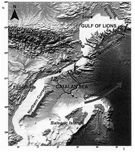 Map of the area showing the paths of the main Northern and Balearic Currents and the location of the Rhone River and Ebro River mouths. Map of the area showing the paths of the main Northern and Balearic Currents and the location of the Rhone River and Ebro River mouths.
Issued from : D. Costalago in Vie Milieu, 2015, 65 (2). [p.102, Fig.1].
 Chart of the Strait of Gibraltar with depth contours in meters, based on Defense Mapping Agency (1980) chart No. 52041. Areas deeper than 400 m are shaded. Chart of the Strait of Gibraltar with depth contours in meters, based on Defense Mapping Agency (1980) chart No. 52041. Areas deeper than 400 m are shaded.
Overlay. Location of essential topographic features, moorings, transects (solid lines between stars) and way-points (in nautical miles) for the runs.
Issued from : Miller C.B. & Clemons M.J., 1988. - Revised life history analysis for large grazing copepods in the subarctic Pacific Ocean. Progress in Oceanography, 20 (4). [p.41, Fig.2.1].
The tropical-temperate zone of the North-east Atlantic shares 466 species (i.e. 61.4 %) with the Caribbean - Sargasso Sea region and 389 species with the Mediterranean (51.1 %).
Certain species may be considered as relicts from the glacial age: Acartia bifilosa, Chiridius obtusifrons, Paramisophria cluthae, Paraeuchaeta norvegica, Stephos scotti, Lubbockia brevis, Oncaea borealis, O. pumilis , and probably Oncaea englishi. Pseudocalanus elongatus originating in the North Atlantic, and also reported in the Gulf of Guinea, was perhaps introduced by the superficial Gibraltar current. Spinocalanus terranovae, observed recently (Lapernat & Razouls, 2001) in deep water near Malta, was previously only known in the Antarctic as Ctenocalanus citer (Uysal & al., 2002).
For Selifonova & al. (2010) there are 20 mediterranean species that were discovered for the first time for the Black Sea (May-June 2001). Species diversity of Mediterranean copepods was unusually high from the region nearest to the Bosporus. Most probably these invaders were carried by the Lower-Bosporus flow. However, same species were also found in the northwestern Black Sea (in good conditions). Nevertheless, the ballast water commercial ships is a possibility of introduction (for example of invasions of Oithona brevicornis in areas of the ports Novorossiysk, Tuapse, Sevastopol). The marked appearance of 33 Mediterranean copepods taxa in the Western Black Sea confirms that process of Mediterranization of fauna (Pusanov, 1967) is continuing.
401 species are common to the Mediterranean and the Indian Ocean (i.e. 66 %).
(For more details on species of the zone Mediterranean - Black Sea (14) see the Chapter (in french) "Distribution géographique des copépodes pélagiques en Méditerranée" ). ).
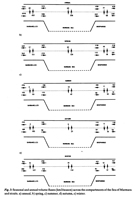 Seasonal and annual volume fluxes (km3/season) across the compartments of the Marmara Sea and straits Dardanelles and Bosphorus.
Seasonal and annual volume fluxes (km3/season) across the compartments of the Marmara Sea and straits Dardanelles and Bosphorus.
Two-layer flow regimes in the Turkish Strait System introduce the brackisk waters of the Black Sea into the Aegean basin of the northeastern Mediterranean throughout the year. A counter flow carries the salty Mediterranean water into the Black Sea via the Marmara deep basin.
The annual volume influx from the Black Sea to the Marmara upper layer is nearly two-fold the salty water exported from the Marmara to the Black Sea via the Bosphorus underflow.
Issued from : S. Tugrul, S.T. Besiktepe & I. Salihoglu in Mediterranean Marine Science, 2002, Vol. 3/1. [p.37, Fig.3].
Méditerranée et Mer Noire
Détroit de Gibraltar :
Le détroit de Gibraltar, qui fait communiquer l'Atlantique et la Méditerranée, est un exemple des courants de densité.
L'afflux de surface des eaux de l'Atlantique moins salée dans la Méditerranée plus salée d'où l'afflux en profondeur de ces eaux dans l'Atlantique.
La cause essentielle de ces échanges d'eaux est l'augmentation de salinité et la dénivellation que produit l'évaporation importante des eaux méditerranéennes. Selon les évaluations de Nielsen, l'excès d'évaporation sur l'apport des eaux douces enlèverait par an à la Méditerranée 3000 kilomètres cubes d'eau, si les eaux de l'Atlantique n'entraient pas par le Détroit de Gibraltar. Les niveaux moyens de l'Atlantique et de la Méditerranée présenterait une différence à l'avantage de l'Atlantique de l'ordre de quelques centimètres selon la saison et une dénivellation variable d'une année à l'autre.
Sans parler des courants de marée qui compliquent le phénomène, il existe au milieu du détroit, un courant superficiel permanent d'Ouest en Est, qui varie avec le vent, et dont la vitesse moyenne est supérieure à 1 nœud, et dépasse parfois 2 nœuds.
La forme des rivages en Espagne comme en Afrique du Nord change légèrement la direction de ce courant ; le long de terre, il se produit, outre les courants de marée, des contre-courants dirigés vers l'Ouest.
Le courant de surface se fait sentir jusqu'à 100 m de profondeur environ. Plus profondément, il existe un courant en sens contraire, que révèlent les mesures de salinité. L'eau atlantique, qui pénètre en surface par le détroit, a une salinité de 36 ; en profondeur, dans le détroit, la salinité dépasse 37 et atteint même 38, eau ne pouvant provenir que de la Méditerranée.
Idrac, dans la partie la plus étroite du détroit, au Sud de Tarifa, a constaté en surface, un courant dirigé vers l'Est-Nord-Est avec une vitesse de 1,4 nœud ; à 100 m, même direction , vitesse 0,8 nœud ; au dessous de 100 m le courant tourne brusquement vers l'Ouest-Sud-Ouest pour y demeurer jusqu'au fond, avec une vitesse 1,1 nœud à 200 m, 4,2 nœud à 300 m, 0,9 nœud à 400 m, 0,5 nœud à 500 m.. D'autres observations ont montré que le courant du fond était plus fort que le –courant de surface, atteignant parfois une vitesse de 4 nœuds.
Ces eaux méditerranéennes, transportées en profondeur dans le détroit de Gibraltar, sont en partie arrêtées par les seuils transversaux qui barrent le détroit, et suivent les chenaux située au Nord et au Sud du banc de Spartel. La force déviante de la rotation terrestre fait suivre à l'écoulement méditerranéen de préférence le chenal situé à sa droite (chenal du Nord), et l'on peut reconnaître ces eaux méditerranéennes doublant le Cap Saint-Vincent et se dirigeant ensuite vers le Nord le long de la côte du Portugal. Mais en même temps, sur la gauche de ce courant, se forment des tourbillons qui ont pour effet de mélanger une partie des eaux méditerranéennes avec les eaux atlantiques, si bien, qu'en définitive, les eaux méditerranéennes paraissent s'épanouir en éventail à la sortie du détroit. Certes leur salinité diminue rapidement, tombant à 37 dès la sortie vers l'Ouest du détroit, à 36 à 500 milles. Ces eaux d'origine méditerranéenne, à un millier de mètres de profondeur, se font reconnaître par une température et une salinité légèrement plus fortes que celles des couches voisines, jusque dans les parages de l'Irlande au Nord et des Canaries, voire la Mer des Sargasses, au Sud (G. Roux, 1943).
Bassin Occidental :
Presque partout l'influence des vents est prépondérante sur la formation des courants, ceux-ci pouvant dépasser 2 nœuds.
Le courant général d'Ouest vers l'Est, qui entre en surface par le Détroit de Gibraltar, continue à suivre la côte d'Algérie à la vitesse d'un demi-nœud par temps calme. Le long de la côte d'Espagne et du Maroc, on observe assez souvent des contre-courants dirigés vers l'Ouest.
Le courant se poursuit, pour partie le long de la côte occidentale de la Sardaigne, et pour une autre partie sur la côte Nord de la Sicile, remontant vers le Nord-Ouest en suivant les côtes italiennes. Dans le Golfe de Gênes il s'oriente vers l'Ouest le long des côtes de Provence. Dans le Golfe du Lion il s'oriente vers le Sud sous l'effet, le plus souvent, des forts vents du Nord à Nord-Ouest (Mistral et Tramontane) et de la configuration bathymétrique du Golfe. Le courant induit par ces coups de vent peut atteindre des vitesses de 2 à 4 nœuds. Ce courant général ne suit pas exactement les indentations du rivage, allant directement d'un point saillant au point suivant, d'où l'existence dans les baies d'un contre-courant qui suit le rivage en sens inverse du courant principal.
A Marseille, compte tenu de la configuration de la côte par rapport à la direction du vent de Nord, un mécanisme d'upwelling apparaît.
Sur les côtes catalanes et espagnoles, le courant est dirigé vers le Sud-Ouest, formant ainsi dans le bassin occidental de la Méditerranée un circuit complet en sens inverse des aiguilles d'une montre.
Entre la Sicile et la Tunisie Détroit Siculo-tunisien, il existe un courant à peu près permanent vers l'Est, dont la vitesse peut dépasser 1 nœud.
Bassin Oriental :
Le courant superficiel général en provenance de la Mer d'Alboran suit vers l'Est la côte lybienne et d'Egypte.
Avant la régularisation du Nil, due au nouveau barrage d'Assouan (achevé en 1970), pendant la crue du Nil qui commence en juin-juillet pour finir en septembre, le courant portant à l'Est devant le delta devenait irrégulier ; le courant du Nil se faisait sentir à 2 ou 3 milles de l'embouchure, et ses eaux douces ne se mélangeaient pas avec celles de la mer. Le courant reprenait sa direction normale avant d'arriver à Port-Saïd.
Désormais, les eaux de cette région sont plus normalement salées.
Le courant remonte le long des côtes israélienne et syrienne, vers le Nord-Est et le Nord, d'environ 6 milles par jour.
A l'époque des crues du Nil, les eaux moins salées se faisait sentir sur ces côtes, où l'on observait au mois de septembre une diminution très sensible de la salinité.
Sur la côte sud de la Turquie, le courant est dirigé vers l'Ouest. En mer Egée, il remonte vers le Nord le long des côtes d'Anatolie, puis à la suite du courant des Dardanelles, qui s'écoule régulièrement à une vitesse de 3 à 4 nœuds de la Mer Noire vers la Méditerranée, le courant général redescend vers le Sud au milieu de la Mer Egée et le long des côtes de Grèce (ainsi s'explique que les eaux soient plus salées dans la partie orientale de la Mer Egée que dans la partie occidentale) a une vitesse moyenne d'un quart de nœud. Dans les chenaux étroits, sa vitesse est renforcée, peut dépasser 1 nœud, et même atteindre, lorsque le vent est dans le sens du courant, des vitesses considérables (7 nœuds dans le Canal Doro entre l'île Andros et Eubée).
Au Cap Matapan, le courant porte à l'Ouest ; il remonte la Mer Ionienne en contournant la Grèce. Un autre courant suit les le Sud les côtes de Sicile, et termine ainsi le circuit du bassin oriental de la Méditerranée, circuit dans le sens inverse des aiguilles d'une montre (comme celui du bassin occidental).
Mer Adriatique :
Un courant côtier général, arrivant par le Canal de Corfou, se dirige vers le Nord-Ouest le long de la côte orientale, contourne le Golfe de Venise, et se dirige vers le Sud-Est le long de la côte d'Italie, décrivant ainsi un circuit en sens inverse des aiguilles d'une montre.
A la hauteur des îles Lahosta, une branche de ce courant est déviée vers l'Ouest et le Sud-Ouest, vers Pelagosa et le Cap Gargano, où elle va renforcer le courant Sud-Est de la côte italienne. Une autre branche importante s'écarte au large du Golfe de Quarnero et coule vers la côte occidentale, où elle s'unit au courant descendant vers le Sud-Est. La vitesse de ces courants est en moyenne de 0,3 nœud dans le bassin méridional, de 0,5 nœud dans le bassin septentrional ; mais les vents peuvent augmenter leur vitesse jusqu'à 2 nœuds.
Le Bosphore et les Dardanelles :
Le Bosphore et les Dardanelles (Hellespont), situés aux extrémités Est et Ouest de la Mer de Marmara, sont parcourus par des courants très forts. Quels que soient les vents qui règnent, le courant général porte toujours de la Mer Noire vers la Mer de Marmara et la Méditerranée.
Les nombreuses sinuosités des chenaux donnent lieu à des contre-courants et des remous.
Dans la partie la plus resserrée du Bosphore, à la hauteur d'Arnaout Keuy, où la largeur n'est que de 530 mètres, la vitesse peut atteindre 4 à 5 nœuds.
Dans les Dardanelles, le courant peut atteindre une vitesse de 4 nœuds devant Canakkale (Tchamak Kalessi).
En profondeur, le courant est en sens inverse du courant de surface et se dirige de la Méditerranée et da la Mer de Marmara vers la Mer Noire. La profondeur à laquelle le courant change est de 15 mètres à la hauteur d'Istanbul, de 40 mètres dans le haut Bosphore. La vitesse du courant de profondeur peut dépasser 2 nœuds. Dans le haut Bosphore, au Nord de Seriyer (Therapia), le courant de profondeur est normalement plus fort que le courant de surface.
L'explication de ce double courant réside dans les différences de densité de la Mer Noire, de la mer de Marmara et de la Méditerranée.
La Mer Noire a une salinité de 18 ; elle atteint 20 à 200 mètres de profondeur, et elle augmente lentement jusqu'au fond sans toutefois dépasser 22,5. Dans la Mer de Marmara, la salinité de surface est de 21, mais elle augmente rapidement avec la profondeur, elle est à 30 mètres de 37,5 et elle dépasse 38 à partir de 50 mètres.
Les courants du Bosphore et des Dardanelles ont leur vitesse modifiée par la direction des vents, leur force et leur durée. Après une période prolongée de vents du Nord, le courant du Bosphore atteint son maximum de vitesse, et le courant de surface s'étend plus profondément qu'en temps normal ; par vents du Sud, la vitesse diminue et devient parfois presque nulle.
La mer Noire :
Le déversement des grands fleuves qui s'y jettent, Danube, Dniestr, Dniepr, Don, ainsi que les précipitations atmosphériques très abondantes maintiennent une salinité très inférieure à celle de la Méditerranée et de la Mer de Marmara.
L'eau déversée par les fleuves est déviée vers la droite par la rotation terrestre ainsi que les vents déterminent le courant de surface du Bosphore conduisant ces eaux de la Mer Noire vers la Mer de Marmara et au-delà vers la Méditerranée.
L'accumulation des eaux vers le Bosphore est si importante qu'une partie est refoulée sur les côtes d'Anatolie, où se forme un courant vers l'Est, suivant le contour de la côte. Il en résulte un circuit dans le sens inverse des aiguilles d'une montre, dont la vitesse varie de 0,5 à 1 nœud. Le courant est particulièrement marqué entre le delta du Danube et le Bosphore, et, par vent du Nord, surtout au printemps où les apports fluviaux sont considérables, la vitesse de ce courant peut dépasser 1 nœud.
Le long des côtes de Turquie et de Bulgarie, jusqu'à la Baie de Baltchik, on observe au voisinage immédiat des côtes, un courant inverse du courant général et dirigé au Nord. De même sur les côtes d'Anatolie, entre Sinope (Sinop) et Kerempeh, des contre-courants vers l'Ouest.
Les eaux de la Mer d'Azov s'écoulent normalement en surface vers la Mer Noire par le Détroit de Kertch (Kerchenskiy Proliv) à une vitesse voisine de 1 nœud, qui peut atteindre 3 nœuds au printemps. Après des coups de vent prolongés du Nord-Est, qui ont accéléré le courant et fait baisser le niveau de la mer, il arrive que le courant s'inverse, et se dirige alors de la Mer Noire vers la Mer d'Azov, à une vitesse qui peut dépasser 0,5 nœud. Ce courant anormal s'observe surtout en hiver.
Le Détroit de Kertch montre qu'il suffit d'une très faible profondeur (7 mètres) pour que s'établissent les doubles courants de densité. L'eau de la Mer d'Azov, abondamment alimentée par le fleuve Don, a une salinité variant de 7 à 11, tandis que la salinité de la Mer Noire est de 16 à 17.
Dans le Détroit de Kertch, un courant superficiel, s'étendant jusqu'à une profondeur de 5 mètres, charrie l'eau adoucie de la Mer d'Azov vers la Mer Noire ; au dessous, un courant contraire transporte dans la mer d'Azov l'eau plus salée de la mer Noire.
Références :
J. Rouch, 1948. Traité d'Océanographie physique. 3 : Les mouvements de la mer. Payot, Paris.
Contributions to the Oceanography of the Western Alboran Sea. NORDA, 315, April 1985. XXIXth Congress and Plenary Session of the International Commission for the Scientific Exploration of the Mediterranean Sea, Lucerne October 11-19, 1984.
J. Rodriguez, 1982. Oceanografia del Mar Mediterraneo. Edic. Piramide.
P.A. Auger, 2011. - Modélisation des écosystèmes planctoniques pélagiques en Méditerranée nord-occidentale - Impact des eaux du Rhône à l'échelle du plateau du golfe du Lion et variabilité inter-annuelle à décennale au large. Thesis Université Paul Sabatier, Toulouse III, 1-242 pp.
Atlas of Pilot Charts http://msi.nga.mil/NGAPortal/MSI.portal?_nfpb=true&_pageLabel=msi_portal_page_62&pubCode=0003 NATIONAL GEOSPATIAL-INTELLIGENCE AGENCY (USA)
Zones: Venezuela - Caribbean - Sargasso Sea (7)  ; NW North Atlantic (Nova Scotia-Labrador Sea) (11) ; NW North Atlantic (Nova Scotia-Labrador Sea) (11) 
|
7 |
11 |
Total species: |
714 (27.8 %) (+ 10 ind.) |
259 (10.1 %) (+ 2 ind.) |
Calanoida: |
557 |
204 |
other orders |
157 |
55 |
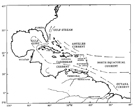 Issued from : Murphy S.J., Hurlburt H.E. & O'Brien J.J. in Journal of Geophysical Research, 1999, 104 (C1). [p.1435, Fig.2].
Issued from : Murphy S.J., Hurlburt H.E. & O'Brien J.J. in Journal of Geophysical Research, 1999, 104 (C1). [p.1435, Fig.2].
Schematic Caribbean circulation drawn from pilot charts [from Duncan et al.,1982].
 Issued from : R. Margalef in The pelagic ecosystem of the Caribbean Sea. Symp. Invest. Res. Caribb. Sea and adjacent region: 1971, 483-498 (UNESCO, SC. 70/D.71/AS). [Fig.1]
Issued from : R. Margalef in The pelagic ecosystem of the Caribbean Sea. Symp. Invest. Res. Caribb. Sea and adjacent region: 1971, 483-498 (UNESCO, SC. 70/D.71/AS). [Fig.1]
Average dynamic topography of the American Mediterranean, in dynamic meters.
For the Gulf of Mexico (North of the double line), data of Duxbury (1962) and contours refered to the surface of 1000 decibars. For the Caribbean (South of the double line), data of Gordon (1967) and reference to the 1200 db level.
The areas of presumible upwelling are covered by points, and the areas of possible sinking are lined.
Arrows indicate the principal currents.
 Issued from: E. Le Danois in L'Atlantique. Albin Michel (ed.), Paris, 1938. [p.112].
Issued from: E. Le Danois in L'Atlantique. Albin Michel (ed.), Paris, 1938. [p.112].
Topography of Caribbean Sea and Gulf of Mexico.
Mer des Antilles et Golfe du Mexique :
La Mer des Antilles et le Golfe du Mexique sont traversés par le courant Nord équatorial et une fraction du courant Sud équatorial, ces deux courants s'étant réunis à l'ouest de la région occupée par le contre-courant équatorial prenant naissance vers le méridien 42° Ouest en direction du bassin de Sierra-Léone.
Une partie de ces courants équatoriaux s'écoule dans la Mer des Antilles, à travers les détroits qui séparent les îles, et dont la profondeur est souvent d'un millier de mètres. Le courant vers l'Ouest est, en toute saison, de 1 nœud, atteignant parfois en été 3 nœuds. Le courant côtoie l'extrémité de la presqu'île du Yucatan, et pénètre dans le Golfe du Mexique. A part un léger courant qui fait tout le tour du Golfe du Mexique, les eaux gagnent directement la côte nord de Cuba pour former, dans le détroit de Floride le Gulf Stream.
La partie des courants équatoriaux qui n'entre pas dans la Mer des Antilles, longe, à une vitesse modérée, les côtes Nord de Porto-Rico, de Haïti et de Cuba, et rejoint le Gulf Stream au large de la côte de Floride.
Dans la Mer des Antilles, le courant est plus fort dans la partie Sud que dans la partie Nord, il dépasse rarement une vitesse de 2 nœuds et constitue à proprement parler plus un mouvement général des eaux qu'un véritable courant. Le long des côtes il existe des contre-courants dont la vitesse peut être assez grande. Un contre-courant portant à l'Est se manifeste entre les îles qui bordent la côte du Venezuela et la terre ferme, mais c'est surtout à partir de la côte de Colombie qu'il atteint une vitesse de 0,5 à 1 nœud.
Dans la partie Sud correspondant au Costa Rica, le contre-courant atteint une vitesse de 2 nœuds.
Dans le Golfe du Honduras, le courant équatorial se fait sentir jusqu'au voisinage de la côte et ce n'est qu'à proximité du rivage que l'on observe un contre-courant vers le Sud et vers l'Est.
De même le long des côtes Sud de Cuba et de Haïti, il existe un contre-courant vers l'Est, dont la vitesse est en moyenne de 1 nœud.
Entre Cuba et la presqu'île du Yucatan, l'axe du courant dirigé vers le Nord est situé à environ 6 milles de la ligne des fonds de 180 mètres du banc de Campêche, par des profondeurs variant de 360 à 755 mètres. La limite Ouest du courant est formée par le banc de Campêche, sa limite Est passe à 20 milles du cap San Antonio (Cuba). A partir de ce cap, les vitesses moyennes du courant sont de 1 nœud à 30 milles, 1,5 nœuds à 50 milles, 2,8 nœuds à 65 milles, 3,5 nœuds à 78 milles, 0,5 nœud à 94 milles, soit à 20 milles de la côte du Yucatan. Le long de la côte de Cuba et sur le banc de Campêche, il existe un léger contre-courant vers le Sud.
La branche principale du courant équatorial se dirige directement du canal du Yucatan au détroit de Floride à une vitesse de 2 nœuds. Une autre branche du courant équatorial fait le tour par l'Ouest du Golfe du Mexique à la vitesse de 1 nœud. Cette branche varie de largeur au cours de l'année, et se fait sentir plus au large des côtes de juillet à octobre. Dans tout le Golfe, au voisinage du rivage, un contre-courant a par endroit une vitesse de 1 nœud.
Au centre du Golfe, vers le 27° de latitude Nord et 88° de longitude Ouest, il existe, sur un diamètre de 80 milles environ une zone sans courant, où s'accumulent des végétaux et débris flottants, et dont les eaux vertes contrastent avec les eaux bleues du courant équatorial.
Quant au Mississipi, son courant se fait sentir de 10 à 15 milles au large suivant les hauteurs d'eau. La séparation de l'eau bleue avec l'eau jaune du fleuve est nettement tranchée.
R. Margalef (1971) compare cette méditerranée américaine avec son homologue européenne, ces deux mers supposées issues de l'ancienne Téthys. La Méditerranée et la mer Noire présentent une surface de 2,996 millions de km2 contre 4,319 millions de km2 pour la mer des Antilles et le Golfe du Mexique. L'estimation de la production primaire (g C/m2/an) et de 25-80 pour la première, contre 40-120 pour la seconde. Il apparaît que dans le second cas la production soit supérieure à celle de son équivalent européen, mais que son exploitation piscicole est sous-exploitée.
Dans le premier cas l'échange avec l'Atlantique conduit à une perte des nutrients, qui doit être compensée par le lessivage des terres apportant une concentration équilibrée relativement basse. Dans le second cas la structure hydrographique et la circulation montre un apport de phosphate beaucoup plus élevé, les bassins profonds contenant une eau riche en nutrients ; au moins aux niveaux disponibles pour la fertilisation, la concentration en phosphate excède 0,3 µg-at. P/l. La stratification des eaux limite les possibilités des mélanges verticaux, mais dans certaines zones les upwellings atteignent une importance jamais observée en Méditerranée européenne (Sturges, 1965). Le Mississipi contribue à un important apport de phosphate (2 à 19-6 mg P/m3) (Riley, 1937, Davis, 1954), comme les îles des Caraïbes représentent des sites de fertilisation.
Références :
J. Rouch, 1948. Traité d'océanographie physique, p. 309-311. Edit. Payot, Paris.
Atlas of Pilot Charts http://msi.nga.mil/NGAPortal/MSI.portal?_nfpb=true&_pageLabel=msi_portal_page_62&pubCode=0003 NATIONAL GEOSPATIAL-INTELLIGENCE AGENCY (USA)
La Mer des Sargasses :
Au centre du circuit de l'Atlantique Nord, à mi-distance entre les Bahamas et les Açores, se trouve une grande étendue d'eau connue sous le nom de Mer des Sargasses. Nom dû à l'abondance des algues, voisines des Fucus, qui flottent à la surface grâce à des vésicules pleines de gaz et qui jouent le rôle de flotteurs.
Il est rare de trouver des masses de Sargasses agglomérées entre elles dépassant un diamètre d'une trentaine de mètres. Parfois, sous l'action du vent, les Sargasses se groupent en longues files ; le plus souvent elles se rencontrent en touffes isolées, séparées par de vastes espaces d'au libre. L'abondance de ces macro-algues est très variable d'une année à l'autre ; J. Rouch en 1939 observe que les algues sont beaucoup moins nombreuses qu'en 1907.
Non seulement cette abondance d'algues rend la mer des Sargasses distincte des autres parties de l'Océan Atlantique, mais ses eaux montrent aussi des caractères très marqués.
Ces eaux ne sont pas immobiles, mais animées de dérives diverses, assez confuses sur les cartes, et participent quelque peu à la circulation générale. Elles se signalent par leur forte salinité, supérieure à 37, voire 37,5, par leur forte température dépassant parfois 28°C, par leur couleur bleue foncée, par leur grande transparence (le disque de Secchi est clairement vu par l'œil à des profondeurs de plus de 60 mètres. En fait il n'y a pas de grande différence entre les eaux de la mer des Sargasses et les eaux du Gulf Stream. Les diagrammes T-S (température et salinité caractérisant une masse d'eau) pour les deux régions sont souvent semblables. Certains ont cru devoir réunir en une seule région la mer des Sargasses et le Gulf Stream.
Les caractères particuliers de cette mer profonde (sa profondeur moyenne dépasse 4000 m, et l'on y trouve des profondeurs de près de 7000 m) s'expliquent par la forte salinité due à l'absence d'arrivée d'eau continentale, l'absence de pluie dans cette zone de calmes tropicaux et d'évaporation intense, et des courants d'eau salée qui l'entoure, région de faible nébulosité et de hautes températures de l'air. Ces eaux salées, d'une densité assez grande malgré leur température élevée, ont tendance à s'enfoncer et à transporter en profondeur les eaux de surface. Ainsi, jusqu'à plus d'un millier de mètres, on observe dans la mer des Sargasses des températures supérieures à celles des parties voisines de l'Océan Atlantique. La transparence des eaux est due à l'éloignement de tout apport terrigène, à une circulation faible, et à une plus grande rareté du plancton, peu stimulé par des remontées d'eau profonde riche en sels nutritifs.
Il est inutile de rappeler que cette mer est un des hauts lieux de la ponte des anguilles.
Références :
J. Rouch, 1948. Traité d'océanographie physique, p. 309-311. Edit. Payot, Paris.
Neveux J., Vaulot D., Courties C. & Fukai E., 1989. Green photosynthetic bacteria accociated with the deep chlorophyll maximum of the Sargasso Sea. C.R. Acad. Sci. Paris, 308 , ser. III, p. 9-14.
Atlas of Pilot Charts http://msi.nga.mil/NGAPortal/MSI.portal?_nfpb=true&_pageLabel=msi_portal_page_62&pubCode=0003 NATIONAL GEOSPATIAL-INTELLIGENCE AGENCY (USA)
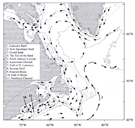 Major currents of the northwest Atlantic shelf and Labrador Sea region.
Major currents of the northwest Atlantic shelf and Labrador Sea region.
Issued from : E.J.H. Head & D.D. Sameoto in Deep-Sea Res., II, 2007, 54. [p.2688, Fig.1].
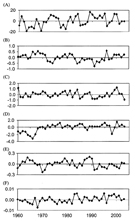 Anomalies for the 1960-2003 period for the North Atlantic Oscillation (NAO, A), depth averaged temperatures on the Newfoundland shelf (B), the eastern Scotian shelf (C), and the central/western Scotian shelf (D), and for the depth averaged salinities (E) and stratification indices (F) on the Newfoundland shelf.
Anomalies for the 1960-2003 period for the North Atlantic Oscillation (NAO, A), depth averaged temperatures on the Newfoundland shelf (B), the eastern Scotian shelf (C), and the central/western Scotian shelf (D), and for the depth averaged salinities (E) and stratification indices (F) on the Newfoundland shelf.
Nota: The time series of the NAO index (variations in climate indices) reveals a period of sustained negative values during 1960s and a period of predominantly positive values during the 1990s, the latter also including a dramatic decrease to a negative value in 1996 and subsequent recovery. For 2001-2003, the NAO index was either negative or neutral.
Water temperatures (at station 27) at the east Newfoundland were above normal in the 1960s, coldest in the early 1990s, rose throughout the rest of the 1990s, with 1-year high value in 1996, and did not change much after 1999s. On Misaine Bank on the east Scotian shelf water temperatures were cool in both the early 1960s and the mid-1980s to the early 1990s, with peak values in 1999 and 2000. In Emerald Basin, on the central/western Scotian shelf, water temperatures were low in the 1960s and generally slightly above average in the 1990s, with the 1-year decrease to lower than average values in 1998. On the newfoundland shelf, salinities were generally below the 1960-2003 average after 1990, rising to slightly above average vaues in 2002-2003.
Stratification there generally increased over the 1960-2003, with a slight decrease in 2002-2003.
The relationship between temperature and the NAO index was examined using lags of up to 4 years for the three ares. The 1960-2003 depth averaged water temperatures were negatively correlated with the NAO index on the Newfoundland shelf with no lag, negatively correlated with the NAO index on the eastern Scotian shelf with a 2-year lag, and posiitively correlated with the NAO index on the western Scotian shelf with a 2-year lag.
Issued from : E.J.H. Head & D.D. Sameoto in Deep-Sea Research II, 2007, 54. [p.2691, Fig.3].
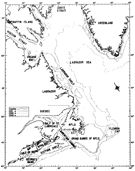 Study areas of the northwest Atlantic for which planktonic copepod species occurrences were recorded.
Study areas of the northwest Atlantic for which planktonic copepod species occurrences were recorded.
Issued from : M.J. Tremblay & J.T. Anderson in Annotated species list of marine planktonic copepods occurring on the shelf and upper slope of the northwest Atlantic (Gulf of Maine to Ungava Bay). Can. Spec. Publ. Fish. Aquat. Sci., 69. [p.2, Fig.1].
This reproduction is a copy of an official work that is published by the Government of Canada and it has not been produced in affiliation with, or with the endorsement of the Government of Canada.
 Currents of the Gulf of St. Lawrence.
Currents of the Gulf of St. Lawrence.
Issued from : Published by Oceans and Science Branch, Fisheries and Oceans Canada in The Gulf of St. Lawrence. A unique Ecosystem, 2005.
This reproduction is a copy of an official work that is published by the Government of Canada and it has not been produced in affiliation with, or with the endorsement of the Government of Canada.
Le Gulf Stream :
Il résulte des courants nord-équatorial et sud-équatorial, dirigés tous deux de l'Est (Continent africain) vers l'ouest (Continent américain), ayant leurs origines dans les vents alizés orientés du Nord-Est au Sud-Ouest dans l'hémisphère boréal et du Sud-Est au Nord-Ouest dans l'hémisphère austral.
Ces alizés entrainent les eaux de telle sorte que l'équateur est longé par un courant superficiel mord-équatorial et un courant sud-équatorial, dirigés tous deux de l'Est vers l'Ouest.
De ces deux courants, le plus fort est le courant du Sud. Il prend naissance dans les environs de l'île Annobon, ou immédiatement au sud de l'équateur entre les longitudes 2° et 8° Est, et se fait sentir sur une large bande qui s'étend de 2°N à 3°N jusqu'à la latitude de 20° Sud. Il commence son cours à la vitesse d'environ 15 milles par jour. Peu à peu sa direction s'incline vers le Nord, sa vitesse augmentant progressivement, surtout à l'Ouest du méridien de Greenwich, elle est plus forte pendant l'été de l'hémisphère Nord, et elle atteint une vitesse de 2 noeuds 5 au voisinage de la côte du Brésil. Au cap San-Roque, le courant se bifurque, la branche principale suit la côte de Guyane, et s'unit au courant nord-équatorial qu'elle renforce, l'autre s'infléchit vers le Sud.
Le courant nord-équatorial prend naissance à la hauteur des îles du Cap Vert, sa direction n'est bien définie qu'entre les latitudes de 5° N et 10° N. Sa vitesse est généralement moins forte que celle du courant équatorial Sud. Cependant, durant l'été, vers le 20e degré de longitude Ouest, on a observé des vitesses de près de 3 nœuds. Ces flux pénètrent dans la Mer des Caraïbes et le Golfe du Mexique par le détroit du Yucatan.
C'est donc une énorme quantité d'eau chaude qui pénètre dans le Golfe du Mexique et qui finit par ressortir en un jet puissant par le détroit entre les Florida Keys et Cuba, lieu considéré comme l'origine du Gulf Stream. Les vitesses moyennes de 3 à 5 noeuds sont maximales au large du Cap Florida (dénommé aussi comme ''Courant de Floride''). En 1948, Jean Rouch donnait comme évaluation son volume à 24 millions de mètres cubes par seconde, soit 22 fois plus que tous les fleuves de la terre réunis. Sa température est de 27 °C et sa vitesse d'une dizaine de kilomètres à l'heure. Dans cette partie du Gulf Stream, les eaux à la surface ont une salinité de 36 à 36.5 à la profondeur de 200 mètres et la température moyenne des eaux de surface et de 26°,5 C. A partir de ce moment, le Gulf Stream s'étale en éventail vers le Nord-Est sous l'effet à la fois du changement de direction des rivages et de la rotation terrestre. En même temps, il se ralentit peu à peu, sa vitesse est en moyenne de 2 nœuds au large de Savannah, à 1,5 nœud au large du Cap Hatteras ; toutefois on observe une variation annuelle marquée de la vitesse du courant qui est deux fois plus forte de février à avril que d'août à octobre. Vers la latitude de 30° N, le Gulf Stream reçoit l'afflux des eaux du courant des Antilles, les deux courants étant parfois séparés l'un de l'autre jusqu'à cette latitude par un léger contre-courant vers le Sud. Des mesures ont montré que le courant vers le Nord-Est n'a pas en surface plus de 130 milles de large ; en profondeur, le courant est sensible à plus de 1000 mètres de profondeur, et, jusqu'à 500 mètres, il a souvent une vitesse de plus d'un nœud. Dans son parcours des tropiques vers les latitudes plus hautes, sa température diminue à peine d'un degré pour un changement de latitude de 10°. Jusqu'à 500 mètres de profondeur, les eaux du Gulf Stream sont sensiblement plus chaudes et plus salées que les eaux du large. Ecarté des Etats-Unis, à partir du Cap Hatteras, par l'effet de la rotation terrestre et l'écoulement du courant froid du Labrador, provenant de la Mer de Baffin, au voisinage du Grand Banc de Terre-Neuve. Ces eaux froides, relativement peu salées, plongent sous celles du Gulf Stream. Des mélanges d'eaux finissent par se produire ; la température du Gulf Stream diminue sensiblement, dépassant à peine 20°C en surface, et inférieure à 15°C vers 200 à 300 mètres de profondeur ; sa salinité ne dépasse pas 36,5 et il n'y a plus d'augmentation de salinité avec la profondeur, comme c'était le cas dans le Courant de Floride et au voisinage du Cap Hatteras.
Si les caractéristiques du Gulf Stream sont nettes entre le Détroit de Floride et le Sud de Terre-Neuve, celles-ci n'existent plus à partir de sa rencontre avec le Courant du Labrador. L'impulsion qu'il a reçue au Détroit de Floride est en partie épuisée après un long parcours de 1800 milles. Les hautes températures, la forte salinité, comme la grande vitesse qui le caractérisaient ont peu à peu diminué, ainsi que sa belle couleur bleue. Mais l'eau transportée continue à dériver vers l'Est et le Nord-Est. La dérive due aux vents dominants d'Ouest s'y ajoute, mais cette dérive n'a pas l'action prépondérante, car, par suite de la rotation terrestre, le courant s'infléchit vers le Sud-Est, alors que la plongée des eaux polaires arctiques beaucoup plus froides et denses, maintient ce que l'on dénomme maintenant la dérive de l'Atlantique Nord (North Atlantic Drift) qui se poursuit sur les côtes de Norvège, atteignant la côte mourmane, où les ports de Hammerfest, au delà du cercle arctique, et Petsamo est toujours libre de glace. Son action s'achevant au Spitzberg.
Références :
J. Rouch, 1948. Traité d'océanographie physique, p. 309-311. Edit. Payot, Paris.
Atlas of Pilot Charts http://msi.nga.mil/NGAPortal/MSI.portal?_nfpb=true&_pageLabel=msi_portal_page_62&pubCode=0003 NATIONAL GEOSPATIAL-INTELLIGENCE AGENCY (USA)
Zones: North-Eastern North Atlantic (9)  ; North Sea-Baltic Sea (9') ; North Sea-Baltic Sea (9')  ; North Atlantic (Southern Iceland) (10) ; North Atlantic (Southern Iceland) (10) 
|
9 |
9' |
10 |
Total species: |
389 (15.2 %) (+ 4 ind.) |
114 (4.2 %) (1 ind.) |
202 (7.9 %) (0 ind.) |
Calanoida: |
293 |
|
186 |
other orders |
96 |
|
16 |
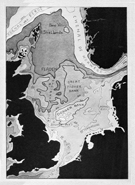 Topography of the North Sea.
Topography of the North Sea.
Issued from: E. Le Danois in L'Atlantique. Albin Michel (ed.), Paris, 1938 .[p.80].
 Feeding areas of herring (after Dragesund & al., 1997), blue whiting (after Blindheim & Skoldal, 1992), and mackerel (suggestive) in the Norwegian Sea.
Feeding areas of herring (after Dragesund & al., 1997), blue whiting (after Blindheim & Skoldal, 1992), and mackerel (suggestive) in the Norwegian Sea.
Issued from : S. Kaartvedt in ICES Journal of Marine Science, 2000, 57 (6). [p.1821, Fig.1].
Herring (Clupea harenus) enter the feeding area from spawning grounds on the Norwegian Shelf, expanding westwards and northwards in accord with the progression of the subsequent spring production in those areas.
Blue whiting and mackerel migrate eastwards and northwards from the spawning grounds west and south of the United Kingdom.
Note the bathymetric map by Bjørn Gjevik, University of Oslo.
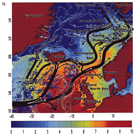 Schematic of the major pathways of near-surface Atlantic water in the northern North Atlantic and Nordic Seas (dark arrows) as derived from near-surface Lagrangian drifter data, in context of superimposed sea surface temperature from AVHHR image in March, 1991.
Schematic of the major pathways of near-surface Atlantic water in the northern North Atlantic and Nordic Seas (dark arrows) as derived from near-surface Lagrangian drifter data, in context of superimposed sea surface temperature from AVHHR image in March, 1991.
Issued from : K.A. Orvik in Geophysical Research Letters, 2002, 29 (19). [p.2.2,Fig.1].
 Main currents around Iceland.
Main currents around Iceland.
Issued from : D.J. Beare, A. Gislason, O.S. Asthorsson & E. McKenzie in ICES J. Mar. Sci., 2000, 57 (6). [p.1546, Fig.1].
Atlantic Water (flighted arrows); Polar Water (normal arrows): Arctic Water; Coastal Water (thin broken arrows).
 The current systems (after Hansen & Killerich) and the location of the hydrobiological sections.
The current systems (after Hansen & Killerich) and the location of the hydrobiological sections.
Issued from : E.A. Pavshtiks in Sarsia, 1968, 34. [p.384, Fig.1].
1 – Canadian Polar and East-Greenland Currents. 2 – Irminger Current. 6 – Circulation of subarctic waters. 4 – West-Greenland Current. 5 – Standard sections of PINRO. 6 – Standard sections during Norwestland I and III. 7 – April-July. 8 – August-September.
7 and 8. Sampling stations.
Davis Strait is here defined as that area between Greenland and Canada bordered by latitudes 55° and 67° N.
Hydrological conditions in the Davis Strait are very similar to those in the Norwegian, Greenland, Barents and Karak Seas though the Davis Strait differs in its greater proximity to the Atlantic Ocean. Arctic and Atlantic waters meet and mix in the Davis Strait, thus forming ''the secondary polar front'' and a cimplex system of circulation of subarctic waters. This creates special conditions which affect the development of the plankton. The influence of Atlantic and Arctic waters upon composition of zooplankton in the Davis Strait has been studied by Aurivillius, 1896; Jespersen, 1934; Kielhorn, 1952; Gruzov, 1961; Kramp, 1963; Grainger, 1961, 1963; Pavshtiks, 1964; Semenova, 1964.
Zones: Antarctic (4) - Sub-Antarctic (3)  ; Arctic Ocean (27) ; Arctic Ocean (27) 
|
4 or 3 |
27 |
Total species: |
394 (15.4 %)(+ 11 ind.) |
184 (7.2 %) (+ 7 ind.) |
Calanoida: |
331 |
147 |
other orders |
63 |
37 |
Antarctic and Sub-Antarctic species :
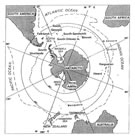 A total of 394 species, i.e. 14.6 % of the marine species, have been reported in the Antarctic Ocean (continent and southern parts of the three oceans). 274 species are present in the South Pacific, 223 species in the southern Indian Ocean and 223 species in the South Atlantic, and some are found in the southern parts of all three oceans. One hundred and fourteen found in contact with the continent or near the ice pack correspond to species adapted to the coldest temperatures. A total of 394 species, i.e. 14.6 % of the marine species, have been reported in the Antarctic Ocean (continent and southern parts of the three oceans). 274 species are present in the South Pacific, 223 species in the southern Indian Ocean and 223 species in the South Atlantic, and some are found in the southern parts of all three oceans. One hundred and fourteen found in contact with the continent or near the ice pack correspond to species adapted to the coldest temperatures.
In view of the imprecisely defined latitudinal limits for the Antarctic convergence, it is probable that two hundred and twenty three forms (i.e. 83.2 %) observed in the sub-Antarctic province come from sub-tropical and temperate zones, carried by surface or deep-water currents. This relatively high immigration level for Copepoda is perhaps accidental, and may constitute pseudopopulations as noted for coccolithophores by Winter et al. (1999) in the Weddell Sea.
Longhurst (1998, p.341) situates this sub-Antarctic ring between the limits of the Polar Front to the South and the sub-Antarctic Front at its sub-tropical convergence to the North.
Fourteen species are characteristic of the sub-Antarctic region, although it is difficult to define the latter from hydrological (Gamberoni et al., 1982) or current (Y. H. Park, 1999) data: Acartia ensifera, Aetideus pseudarmatus, Euchirella latirostris, E. similis, Calanoides macrocarinatus, C. patagoniensis, Candacia cheirura, Clausocalanus ingens, Drepanopus forcipatus, D. pectinatus, Paraeuchaeta eltaninae, Lucicutia rara, Calocalanus fiolenti, C. longispinus.
Thirty four species have been reported only on one side or the other of the Antarctic convergence (or Polar Front): Aetideopsis tumorosa, Aetideus australis, E. rostromagna, Pseudochirella hirsuta, P. mawsoni, Euaugaptilus aliquantus, E. parasetosus, Haloptilus ocellatus, Calanus propinquus, C. simillimus, C. maxima, Clausocalanus brevipes, C. laticeps, Ctenocalanus citer, Subeucalanus longiceps, Paraeuchaeta antarctica, P. biloba, P. dactylifera, Paraeuchaeta parvula, P. rasa, P. regalis, Heterorhabdus austrinus, H. farrani, H. pustulifer, Bathycalanus eltaninae, B. inflatus, Bradycalanus pseudotypicus, Metridia gerlachei, Cornucalanus robustus, Amallothrix dentipes, Stephos longipes, Oithona frigida, Oncaea curvata, Triconia antarctica.
A detailed analysis of the distribution of species is provided by Razouls et al. in Workshop Evolutionary Biology of Antarctic organisms. Curitiba , Brazil . 12-15 May, 1999.
Recent revision by Park & Ferrari, 2009.
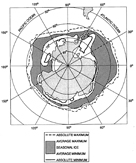 Antarctic Ocean showing the average and absolute maximum and minimum seasonal ice cover (modified from Maykut, 1985).
Antarctic Ocean showing the average and absolute maximum and minimum seasonal ice cover (modified from Maykut, 1985).
Issued from : R.J. Conover & M. Huntley in J. Mar. Syst., 1991, 2. [p.2, Fig.1]
 Southern Ocean.
Southern Ocean.
Issued from : P. Tréguer & G. Jacques in La Recherche, Vol. 17, 1986, n°178. [p.748, Fig.2]
The Southern Ocean occupies 20% of the oceans. It takes the form of a ring 76 million km2 bounded on the north by the Subtropical Convergence and south by the Antarctic continent. By convention we distinguish the Southern Ocean to the Antarctic Ocean, located him south of the polar front. This ocean is covered by ice with a maximum extension in winter reached 25 million km2 (limit of pack).
Ocean-atmosphere interactions and the wind regime (easterly winds near the continent and winds west off) are the source of surface areas of discontinuities such as antactic divergence where the deep waters are rich in nutrients, rising from 2 to 3000 m to the surface. Instead, the convergence zones (Antarctic Convergence or Polar Front and Subtropical convergence) are associated with cold-water dives.
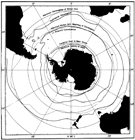 Wind and water transitions in the Southern Ocean.
Wind and water transitions in the Southern Ocean.
Issued from : G.E.R. Deacon in Deep-Sea Res., 1982, 29 (1A). [p.2, Fig.1]
Nota :
The Antarctic divergence is the transition region between the east and west winds. The dotted line nearest the continent shows the location of the average wind boundary. It happens in 68 to 69°S in the Weddell Sea, in 62 to 63°S where the continent extends farther north in the Indian Ocean sector, and in 70 to 71°S north of the Ross Sea. It should be accompanied by evidence of upwelling, and the full line close by shows the circumpolar salitity maximum at 200 m (plotted by Gordon & al., 1978). The only serious discrepancy occurs north of the Ross Sea where other factors may be involved.
The Antarctic convergence : The second dotted line shows the calculated position of the strongest average west wind and maximum northward Rkman drift, and the full line near it is the Antarctic convergence. Although the closely spaced observations and satellite imagery available today emphasize its variability, they are relatively minor variations about what, in the middle of such a wide ocean, must be regarded as a remarkably predictable frontal zone where cold Antarctic water slips below and mixes with warmer water (Kort, 1967). At the surface it is marked by steepening of the meridional gradients of temperature, silicate, and other nutrients, by transitions in phytoplankton and zooplankton, and by a noticeable difference in climate. There is much eddying and interleaving of cold and warm water, but the sustained presence of a weak temperature minimum below the warmer water north of the front is a clear indication of continued sinking. The position of the convergence is based on the finding by Deacon (1933) and MacKintosch (1946) that the surface discontinuity generally occurs close to the latitude where the temperature minimum characteristic of the Antarctic water dips below 200 m on its relatively steep descent below the warmer water. Temperature profiles farther south are clearly marked by a temperature minimum at 100 to 150 m between warmer, less saline, surface water and warmer, more saline, deep water. Profiles farther north are just as clearly marked by warmer, generally well-mixed, water extending well below 200 m. There is greater variability, and more difficulty in interpolating between contra-indicating data, near the S-shaped bend of the convergence in the Scotia Sea. The early studies (Deacon, 1933 ; MacKintosh, 1946) recognized some irregularity and variability in the position of the front.
Although the circumpolar current must be primarily wind driven, its course must be also depend on other factors, for instances the bottom topography, the S-shaped bend of the convergence in the Scotia Sea seems likely to be due to the northern arm of the Scotia ridge.
The effects of heatinh, cooling, and water exchanges on the density distribution and the patch of the current are not so readily apparent, but Stommel (1980) shows how they may determine the latitude in which the main volume of water sinks to form the Antarctic Intermediate Current.
The subtropical convergence : The northernmost full line shows the position of the subtropical convergence, a sharp transition between subantractic water and warmer, more saline water partly derived from strong southward currents. It is generally marked by a surface-temperature discontinuity of 4 or 5°C and a salinity difference of 0.5 p.1000. A particularly sharp crossing was noticed in 41°S southeast of Cape Town (see Würst, 1926). The dotted line close by in figure 1 shows where the calculated Ekman drift, decreasing rapidly to the north, is most convergent. The data compiled over many years usually allow it to be located to within 1 or 2 degrees of latitude, and there are sufficient observations to fix its position in the middle of the Atlantic, Indian, and Pacific sectors. There are special conditions south of the Brazil, Agulhas, and East Australian currents where patches of warm water separate off from the main currents. South of the Brazil current, for example, the main boundary between subtropical and subantarctic waters occurs near 42 to 43°S but the historical data show that patches of the more saline water have reached 47 to 48°S. There is also much irregularity at the boundary with the Falkland current between the Brazil current and Patagonia.
 Temperature section and Salinity in the Indian Southern Ocean along 66°30'E between 40 and 62°S in March 1977.
Temperature section and Salinity in the Indian Southern Ocean along 66°30'E between 40 and 62°S in March 1977.
Issued from : L. Gamberoni, J. Geronimi, P.F. Jeannin & J.F. Murail in Oceanologica, 1982, 6 (3). [p.291, Figures 2, 3]
The data show a frontal zone between 43 and 46°S which separates the antarctic and subtropical regions and within which is concentrated most of the circumpolar current. The frontal zone is due to the coalescence of the antarctic and subtropical convergences into a single convergence zone, effectively eliminating the subantarctic region.
The frontal zone which is located between 43 and 46°S in the Kerguelen region (60-75°E) is located 3 degrees further north, between 41 and 43°S, in the Crozet region (50°E).
The coalescence of the two fronts was due to the northward translation of the antarctic convergence west of Crozet Islands, a possible effect of the bottom topography.
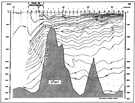 Oxygen section in the Indian Southern Ocean along 66°30'E between 40 and 62°S in March 1977.
Oxygen section in the Indian Southern Ocean along 66°30'E between 40 and 62°S in March 1977.
Issued from : L. Gamberoni, J. Geronimi, P.F. Jeannin & J.F. Murail in Oceanologica, 1982, 6 (3). [p.292, Figure 4]
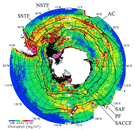 Mean SeaWiFS chlorophyll concentration during austral summer (December 1997 through February 1998) and mean location of the major SO fronts. Displayed fronts include the PF [from Moore et al., 1999a], the SACCF, the SAF [from Orsi et al., 1995], the NSTF and SSTF, and the AC [from Belkin, 1993, 1988; Belkin and Gordon, 1996].
Mean SeaWiFS chlorophyll concentration during austral summer (December 1997 through February 1998) and mean location of the major SO fronts. Displayed fronts include the PF [from Moore et al., 1999a], the SACCF, the SAF [from Orsi et al., 1995], the NSTF and SSTF, and the AC [from Belkin, 1993, 1988; Belkin and Gordon, 1996].
Issued from : Moore, J.K., Abbott, M.R., 2000. - Phytoplankton chlorophyll distributions and primary production in the Southern Ocean. Journal of Geophysical Research, 105(C12) : 709-722. [p.711, Fig.3]
Abbreviations :
| SACCF : |
Southern Antarctic Circumpolar Current Front |
| PF : |
Antarctic Polar Front (Antarctic Convergence) |
| SAF : |
Subantarctic Front |
| SSTF : |
South Subtropical Front |
| NSTF : |
North Subtropical Front |
| AC : |
Aghulas Current |
|
|
 The distribution of zooplankton biomass in the Southern Ocean in the 100-0 m layer (mg/m3) in January-May 1956 and 1957.
The distribution of zooplankton biomass in the Southern Ocean in the 100-0 m layer (mg/m3) in January-May 1956 and 1957.
Issued from : N.M. Voronina in Sarsia, 1968, 34. [p.282, Fig.4]
 Map of zooplankton biomass of the Southern Ocean in the 100-0 m layer.
Map of zooplankton biomass of the Southern Ocean in the 100-0 m layer.
Issued from : N.M. Voronina & A.G. Naumov in Oceanology, 1968, 8 (6). [p.837, Fig.2]
1: < 10 mg/m3; 2: 10-49 mg/m3; 3: 50-99 mg/m3; 4: >100 mg/m3.
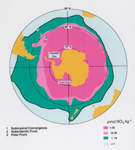 Antarctic chart of fronts and nitrate concentrations (Claude Razouls pers. comm.)
Antarctic chart of fronts and nitrate concentrations (Claude Razouls pers. comm.)
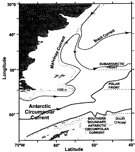 Chart of fronts and general pattern of the Southwestern Atlantic Ocean during January 2001.
Chart of fronts and general pattern of the Southwestern Atlantic Ocean during January 2001.
Issued from : G.A. Thompson, E.G. Dinofrio & A. Alder in J. Plankton Res., 2013, 35 (3), Fig.1
Nota: Structure, abundance and biomass size spectra of copepods and other zooplankton communities in upper waters of the Southwestern Atlantic from 37-61°S, 44-56°W.
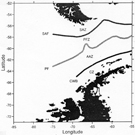 The fronts and zones in the Drake Passage.
The fronts and zones in the Drake Passage.
Issued from :T.J. Grose, J.A. Johnson & G.R. Bigg in Deep-Sea Res. I, 1995, 42 (3). [Fig.1].
Subantarctic Zone (SAZ), Subantarctic Front (SAF), Polar Frontal Zone (PFZ), Polar Front (PF), Antarctic Zone (AAZ), Continental Water Boundary (CWB) and Continental Zone (CZ).
 Topography of the South Atlantic (sub and antarctic regions).
Topography of the South Atlantic (sub and antarctic regions).
Issued from: E. Le Danois in L'Atlantique. Albin Michel (ed.), Paris, 1938 . [p.112].
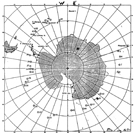 The position of the biological stations of «Norvegia» 1930-1931.
The position of the biological stations of «Norvegia» 1930-1931.
Issued from : P. Ottestad in Scient. Results Norw. Antarct. Exped., 1936, 15. [p.7, Fig.1].
The research vessel «Norvegia», on the 14th October passed Bouvet Island and proceeded thence to the Eastward, past Kerguelen, through the Ross Sea, Bellinghausen Sea and the Weddell Sea. In March 1931 she went back to Bouvet.
The expedition's stations were spread over a very great area and were taken at very different periods of the Antarctic summer. The first stations, east of Kerguelen, were taken in the latter half of November, the last in the weddell Sea in the latter half of January. The hydrographical conditions at one and the same place will naturally have changed very much during the course of such a long period. It is, however, of the very greatest importance to be able to determine whether a station has been taken in an Antarctic or sub-Antarctic area? The border-line between these areas of sea, the Antarctic convergence or polar front, is variously situated in the various areas of the Antarctic Ocean. According to Sverdrup (1933) it lies in the Atlantic and Indian Ocean at about 50°S, whereas, in Bellinhausen Sea it runs at about 60°S.
 The variation of the temperature with depth at stations 5, 7, and 13 (figure left side) and 19, 20, 22, and 24 (figure right side).
The variation of the temperature with depth at stations 5, 7, and 13 (figure left side) and 19, 20, 22, and 24 (figure right side).
Issued from : P. Ottestad in Scient. Results Norw. Antarct. Exped., 1936, 15. [p.9, Figs. 2, 3].
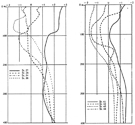 The variation of the temperature with depth at stations 27, 28, 34 , and 38 (figure left side) and 41, 42, 46, and 48 (figure right side).
The variation of the temperature with depth at stations 27, 28, 34 , and 38 (figure left side) and 41, 42, 46, and 48 (figure right side).
Issued from : P. Ottestad in Scient. Results Norw. Antarct. Exped., 1936, 15. [p.10, Figs. 4, 5].
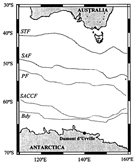 Map of the average positions of the fronts in the Indian sector of the Southern Ocean (south of Australia) during the austral summer (December-February) after Orsi & al. (1995).
Map of the average positions of the fronts in the Indian sector of the Southern Ocean (south of Australia) during the austral summer (December-February) after Orsi & al. (1995).
Issued from : K.T. Takahashi, G.W. Hosie, D.J. McLeod & J.A. Kitchener in Polar Science, 2011, 5. [p.136, Fig.1 (modified)].
STF: Sub-Tropical Front; SAF: Sub-Antarctic Front; PF: Polar Front; SACCF: Southern ACC Front; Bdy: southern boundary of the ACC.
ACC = Antarctic Circumpolar Current.
The southern (SAF-S) branch of the SAF was located at 51°S-53°S. The northern (PF-N) branch of the PF was typically located at approximately 54°S but can be evident at 56.5°S. The PF-S was identified around 60°S. The region north of the SAF-S is defined as the Inter Sub-Antarctic Front Zone (ISAFZ), the region between the SAF-S and the PF-N as the Polar Frontal Zone (PFZ), the region between the two branches of the PF as the Inter Polar Frontal Zone (IPFZ) and the region to the south of PF-S as the Antarctic Zone (AZ).
 Antarctic waters patches near of bottom (after Wüst, 1936).
Antarctic waters patches near of bottom (after Wüst, 1936).
Issued from : J. Rouch in Traité d'océanographie physique. 3 Les mouvements de la mer. Edit. Payot, Paris, 1948. [p.381, Fig.174].
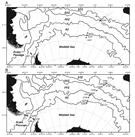 Sampling sites and ACC (Antarctic Circumpolar Current) front configuration during sampling.
Sampling sites and ACC (Antarctic Circumpolar Current) front configuration during sampling.
A) 30th Cruise of R/V "Akademik Ioffe" (during the Southern Hemisphere Summer, December 2009–January 2010).
B) 31th Cruise of R/V "Akademik Sergey Vavilov" (during the Antarctic Spring, October–November 2010).
STF: the Subtropical Front, SAF: the Subantarctic Front, PF: the Polar Front, SACCF: the Southern ACC Front, STZ: the Subtropical Zone, SAZ: the Subantarctic Zone, PFZ: the Polar Front Zone, AZ: the Antarctic Zone.
Issued from : A.N. Stupnikova et al. in Journal of Marine Systems, 2013. 128 [p.176, Fig.1].
Océan Antarctique :
Sous la poussée des vents d'Ouest, qui soufflent avec assez de régularité vers les latitudes comprises entre le 40ème et le 60ème parallèles, les eaux superficielles de l'Océan Austral sont animées d'une vaste dérive vers l'Est, dont la vitesse peut dépasser 1 nœud.
La limite Nord de cette dérive est assez bien marquée par la ligne de convergence subtropicale, sa limite Sud par la ligne de convergence antarctique ou sub-polaire. Cette ligne de convergence antarctique se confond avec le lieu des points présentant en surface un maximum de densité. Il existe entre les latitudes tempérées et l'Atlantique, une région où la densité de l'eau de mer atteint une valeur maximale, de l'ordre de 1,02725. Au Nord et au Sud de cette région, située approximativement vers le 60ème degré de latitude, la densité décroît pour atteindre aux abords du continent antarctique 1,02650 et même 1,026, et aux abords de la Terre de Feu, du Cap de Bonne-Espérance et de la Tasmanie, des valeurs encore plus faibles, voisines de 1,02550.
Au Sud de cette ligne, autour du continent antarctique, les courants ont une composante vers le Nord, souvent très nettement marquée. Les icebergs et les glaces qu'on rencontre jusque vers les latitudes plus basses sont la preuve de cette dérive vers le Nord. Ces courants vers le Nord on fait l'objet d'observations directes. A la lisière de la banquise, J. Rouch a constaté à bord du Pourquoi-Pas ? un courant assez fort, malgré un vent très fort de Nord-Est ; ce courant était assez violent pour miner la banquise par en dessous et déterminer ainsi des clairières d'eau libre.
Dans la Mer de Weddell, l'existence de ce courant a été mise nettement en évidence par les dérives du Deutschland et de l'Endurance.
Le Deutschland, bloqué par la glace le 6 mars 1912 par 74° de latitude Sud et 30° de longitude Ouest, dériva d'abord vers le Nord-Ouest, puis vers le Nord, et fut libéré le 23 décembre 1912 par 64° de latitude, ayant parcouru 600 milles en 9 mois et 17 jours, à la vitesse moyenne de 2 milles par jour.
L'Endurance, bloquée dans les glaces par 77° de latitude Sud le 5 mai 1915, fit naufrage le 27 octobre par 69° de latitude, après avoir parcouru 480 milles en 172 jours, à la vitesse moyenne de 2,8 milles par jour. Les naufragés, réfugiés sur une plaque de la banquise (floe), continuèrent de dériver jusqu'au 63ème parallèle.
L'influence de cette dérive vers le Nord est manifeste sur les températures de l'eau de mer ; alors qu'à l'Ouest de la Terre de Graham l'isotherme de l'eau de mer de zéro suit sensiblement la direction des rivages et s'infléchit jusqu'à atteindre, dans la mer de Bellingshausen, le 69ème et même le 70ème degré, la même isotherme ne dépasse pas vers le Sud le parallèle de 60° dans le secteur de la Mer de Weddell, et plus à l'Est remonte jusqu'au 54ème parallèle.
De même, l'isotherme de 5° qui, à l'Ouest du méridien du Cap Horn suit sensiblement le 58ème parallèle, remonte jusqu'au 55ème degré sous le méridien des Falklands, se rencontre au 52ème degré sous le méridien de la Géorgie du Sud, au 48ème degré sous le méridien de Greenwich.
Ce courant vers le Nord se propage vers les latitudes plus basses (courant des Falklands) qui amène aux environs des îles Falklands des quantités souvent considérables d'icebergs qui peuvent atteindre la latitude de Montevideo.
Dans la Mer de Ross, il existe aussi une dérive vers le Nord, mais moins accusée que dans la Mer de Weddell. L'Aurora, bloquée dans les glaces en mai 1915 par 78° de latitude, finit, après une dérive de 9 mois, par atteindre la mer libre au Nord de la Terre Victoria.
Au Sud du cercle polaire, les vents soufflent plutôt de la partie Est, et sous leur influence les courants marins ont en surface une composante vers l'Ouest, lorsque la forme des rivages ne s'y oppose pas.
La circulation profonde a été étudiée lors des expéditions polaires, en particulier par les Discovery I & II (see G.E.R. Deacon, in Discovery Reports, XV, 1937). Il existe dans les mers australes deux lignes de convergence antarctique ; une ligne située à peu près entre le 50° et 55°de latitude. L'isotherme de 5°C en donne à peu près le tracé. C'est à partir de cette ligne que la couche superficielle plonge sous les eaux d'origine subtropicales.. Au voisinage de la ligne de convergence, prend naissance un courant d'eaux antarctiques qui dérive vers le Nord, en s'enfonçant à des profondeurs de 900 mètres environ. Ce sont des eaux assez froides, d'une forte teneur en oxygène, mais qui se distinguent surtout par une salinité plus faible que celle des couches situées au-dessus et au-dessous d'elles. Ces eaux sont dénommées eaux antarctiques ou subantarctiques.
A une profondeur plus grande, entre 1000 et 3000 mètres, un afflux d'eaux relativement chaudes et salées venues du Nord, s'approche graduellement de la surface, et se distingue par un maximum relatif de température (courant profond du Nord).
Enfin à des profondeurs encore plus grandes, supérieures à 3000 mètres, se trouvent des eaux relativement salées, mais dont la température potentielle est très basse (courant de fond). Ce courant a des ramifications importantes vers le Nord, fait tout le tour du continent antarctique de l'Ouest vers l'Est. Il paraît avoir son origine dans la Mer de Weddell. C'est dans cette mer profonde que l'afflux des eaux atlantiques relativement chaudes se propage le plus loin vers le Sud, jusqu'au 78ème degré de latitude. Elles y perdent leur chaleur en contribuant à la fusion des glaces, deviennent très froides tout en restant assez salées et chutent vers le fond. La Mer de Ross, beaucoup moins profonde que la Mer de Weddell, ne paraît jouer aucun rôle direct dans cette circulation profonde.
Références :
J. Rouch, 1948. Traité d'océanographie physique. 3, Edit. Payot, Paris
Atlas of Pilot Charts http://msi.nga.mil/NGAPortal/MSI.portal?_nfpb=true&_pageLabel=msi_portal_page_62&pubCode=0003 NATIONAL GEOSPATIAL-INTELLIGENCE AGENCY (USA)
Arctic and sub-Arctic species :
407 species (of which 9 are questionable), i.e. 16.7 % of the marine species, have been reported in the Arctic and its surrounding seas (zones 10, 23, 24, and part of 9)
191 species are restricted to the Arctic polar basin (zone 27) (incl. ind.), of which 50 are endemic (incl. 7 ind.).
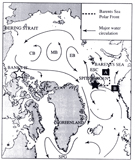 Issued from : R.C. Sundt & W. Melle in Mar. Ecol. Prog. Ser., 1998. [p.208, Fig.1]
Issued from : R.C. Sundt & W. Melle in Mar. Ecol. Prog. Ser., 1998. [p.208, Fig.1]
Major circulation in the Atlantic and Arctic Oceans (after Grotefent & al., 1998); coastlines from GMT (Generic Mapping Tools), Wessel & Smith, 1995.
(black star) Present observation of Calanus marshallae; (white star) observations from Frost, 1974.
CB: Canadian Basin; MB: Makarov Basin; EB: Eurasian Basin; ESC: East Spitsbergen Current; SPG: Subpolar Gyre. Rectangles A and B denote sampling areas for stations.
 Map of the northern Bering Sea and Chukchi. Map of the northern Bering Sea and Chukchi.
The box marks the survey area of the hydrographic conditions (temperature, salinity and chlorophyll) and Gray whale counts during June to September. The arrows show the prevailing current regime.
Issued from : B.A. Bluhm, K.O. Coyle, B. Konar & R. Highsmith in Deep-Sea Resaeach, 2007, 54. [p.2921, Fig.1]. .
 Arctic Ocean showing the average and absolute maximum and minimum seasonal ice cover (modified from Maykut, 1985).
Arctic Ocean showing the average and absolute maximum and minimum seasonal ice cover (modified from Maykut, 1985).
Issued from : R.J. Conover & M. Huntley in J. Mar. Syst., 1991, 2. [p.2, Fig.1]
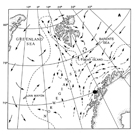 The Barents Sea and part of the North Atlantic.
The Barents Sea and part of the North Atlantic.
Issued from : F. Norrbin in Dissertation, Unv. Göteborg, Fac. Nat. Sci., 1992. [p.7]
Arrows show the major surface currents; dashed arrows represent warm currents and whole arrows cold currents.
The large, solid arrow points at Tromsø (Northern Norway).
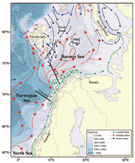 A schematic representation of the main currents and topography in the Barents Sea.
A schematic representation of the main currents and topography in the Barents Sea.
Issued from : P. Dalpadado, R.B. Ingvaldsen, L.C. Stige, B. Bogstad, T. Knutsen, G. Ottersen & B. Ellertsen in ICES Journal of Marine Science, 2012, 9. [Fig.1]
The location of the two standard sections; the FB section at the western entrance to the Barents Sea, and the Gimsøy section in the Norwegian Sea, is indicated.
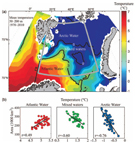 Climate effects on Barents Sea ecosystem dynamics.
Climate effects on Barents Sea ecosystem dynamics.
Issued from : P. Dalpadado, R.B. Ingvaldsen, L.C. Stige, B. Bogstad, T. Knutsen, G. Ottersen & B. Ellertsen in ICES Journal of Marine Science, 2012, 9. [Fig.2]
(a) Mean temperature, 50-200 m, August to early October, based on observations from 1970 to 2010.
The water masses are defined as the Atlantic water (AW: T > 3°C), arctic waters (ArW = T < 0°C), and mixed waters (0°C < T < 3°C).
The grey outline shows the domain for which the area and mean temperatures calculations are performed. The standard FB section is indicated by a black line.
(b) Regression analyses between the areas of AW, ArW, and mixed waters and mean temperature in the three water masses.
 Schematic map of sea currents influencing South and West Spitsbergen (light-grey : Arctic Water ; dark-grey : Atlantic Water).
Schematic map of sea currents influencing South and West Spitsbergen (light-grey : Arctic Water ; dark-grey : Atlantic Water).
Issued from : L. Stempniewicz, K. Blachowiak-Samolyk & J.M. Weslawski in Deep-Sea Research, 2007, 54. [p. 2940, Fig .2].
Nota : Climate variability in the polar regions in the North Atlantic and vicinity, both near-decadal (e.g. related by the North Atlantic Oscillation or NAO) and longer-terms, leads to changes in large-scale circulation patterns and the hydrologic regime of the northern North Atlantic (see Hurrell, 2003).
A crucial oceanographic consequence of a positive NAO index is an increase in the flow of warm Atlantic water into Arctic Ocean (see Dickson & al., 2000). This in turn influences the distribution, abundance, composition and size structure of zooplankton communities (see Beaugrand & al., 2002a).
Changes in the size and energy content of key zooplankton prey affect energy transfer in the pelagic food-web.
Along with the increased influx of Atlantic waters, Arctic zooplankton communities dominated by large coldwater species, retreat to be replaced with small plankters associated with warmer waters during a positive NAO (see Beaugrand & al., 2002b).
Such shifts in zooplankton communities have important consequences for the animal specie that tap into this food base (see Weslawski & al., 1999 a, 2000 ; Karnovsky & al., 2003).
Because of differences of the feeding between birds and fish, domination of large crustaceans in zooplankton favours the feeding of plankton-eating seabirds, while the dominance of small forms redirects the food chain to plankton-eating fish, and only then to fish-eating birds (Guillemots for example). Thus, plankton-eating birds should dominate Arctic avifauna in cold periods and recess in warmer periods, when fish-eaters dominate (see Kitaysky & Golubova, 2000).
Southern and western Spitsbergen are influenced by different ocean currents (Figure 2). The Sørkapp Current brings cold, arctic waters from northeast with a zooplankton community represented by Calanus glacialis, while the warm water West and South Spitsbergen Currents (branches of the North Atlantic Current that itself is an extension of the Gulf Stream) carry small calanoids, Calanus finmarchicus predominates. The extension of each current and hence proportions of arctic and Atlantic water massesaround South Spitsbergen varies depending on the NAO phase.
Total zooplankton biomass is similar in the two water masses, however, the deficiency of large (> 3 mm) crustaceans in Atlantic water dramatically decreases the feeding efficiency of planktivorous seabirds.
 Schematic of the major pathways of near-surface Atlantic water in the northern North Atlantic and Nordic Seas (dark arrows) as derived from near-surface Lagrangian drifter data, in context of superimposed sea surface temperature from AVHHR image in March, 1991.
Schematic of the major pathways of near-surface Atlantic water in the northern North Atlantic and Nordic Seas (dark arrows) as derived from near-surface Lagrangian drifter data, in context of superimposed sea surface temperature from AVHHR image in March, 1991.
Issued from : K.A. Orvik in Geophysical Research Letters, 2002, 29 (19). [p.2.2,Fig.1].
 Issued from : A. Hassel in Zooplankton investigations near ice edge in the western Barents Sea. Havforskningsinstitutttet, Rapport/Notat Nr. BKO 8308. Biol. og kjem. oceanografi, 1983. [Fig.5].
Issued from : A. Hassel in Zooplankton investigations near ice edge in the western Barents Sea. Havforskningsinstitutttet, Rapport/Notat Nr. BKO 8308. Biol. og kjem. oceanografi, 1983. [Fig.5].
Schematic picture of the currents and the Polar front (long dotted line) in the Barents Sea. Straight lines indicate the studied sections. (After Loeng, 1983).
 Issued from : E. Leu, J.E. Søreide, D.O. Hessen, S. Falk-Petersen & J. Berge in Progress in Oceanography, 2011, 90. [p.19, Fig.1].
Issued from : E. Leu, J.E. Søreide, D.O. Hessen, S. Falk-Petersen & J. Berge in Progress in Oceanography, 2011, 90. [p.19, Fig.1].
Conceptual overview of the primary production regimes in the European Arctic along a latitudinal gradient. Modified after Zenkevitch (1963) and Falk-Petersen & al. (2007).
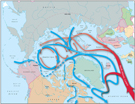 Movement of water in the Arctic Ocean.
Movement of water in the Arctic Ocean.
Blue arrows show cold, relatively fresh water and red arrows show warm, salty water.
Illustration by Jack Cook, WHOI (Woods Hole Oceanographic Institute).
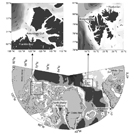 Issued from : M. Daase, S. Falk-Petersen, Ø. Varpe, et al. in Can. J. Fish. Aquat. Sci., 2013, 70. [p.873, Fig.1].
Issued from : M. Daase, S. Falk-Petersen, Ø. Varpe, et al. in Can. J. Fish. Aquat. Sci., 2013, 70. [p.873, Fig.1].
Amundsen Gulf, Franklin Bay, Kongsfjorden, and Rijpfjorden. Also marked are North Water Polynya, Disko Bay, Lurefjorden, and the White Sea.
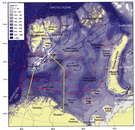 Issued from :E. Eriksen, H.R. Skjoldal, H. Gjøaeter & R. Primicerio in Progress in Oceanography, 2017
, 151 [p.208, Fig.1].
Issued from :E. Eriksen, H.R. Skjoldal, H. Gjøaeter & R. Primicerio in Progress in Oceanography, 2017
, 151 [p.208, Fig.1].
The Barents Sea.
Red arrows show Atlantic water currents, blue arrows Arctic currents and green arrows coastal waters.
Yellow lines show positions of the Barents Sea. Opening (BSO), Hopen (BS-SH) and Kola (KS° sections used for obtaining modelled fluxes of water. The BSO section corresponds to the Fugløya-Bjørnøya oceanographic transect.
Remarks: << The Barents Sea has experienced substantial warming over the last few decades with expansion of relatively warm Atlantic water and reduction in sea ice. See chart 2 (bottom temperature distribution corresponding to 2004 and 2012). and Fig.2 corresponding to the long term series (1980-2015) of annual temperature at the Fugløya-Bjørnøya section (grey line) and 10 years moving average shown with black line.
For the authors the biomass for 25 components of the pelagic community, including macroplankton but not the mesozooplankton (mainly copepods) ranged between about 6 and 30 million tonnes wet weight with an average of 17 million tonnes over the 21-years period. Krill was the dominant biomass component (63%), whereas pelagic fishes (capelin, polar cod and herring) made up 26%, and O-group fish (including demersal species such as cod and haddock) 11% of the biomass on average.
The total estimated biomass of the pelagic compartment remained relatively stable during each of two main periods (before and after 2004), but increased by a factor of two from around 11 million tonnes in the first two around 23 million tonnes in the last period. The pronounced increase reflected the warming between the relatively cold 1990s and the warmer 2000s and was driven mainly by an increase in Krill due presumably to increased advection. Variable recruitment of fish had a strong influence on the variation in pelagic biomass >>.
[CR in the antactic Sea notes the copepods (mainly mesozooplankton) exclusion when the Krill biomass doimates]
 Issued from: E. Eriksen, H.R. Skjoldal, H. Gjøaeter & R. Primicerio in Progress in Oceanography, 2017, 151 [p.209, Fig.3].
Issued from: E. Eriksen, H.R. Skjoldal, H. Gjøaeter & R. Primicerio in Progress in Oceanography, 2017, 151 [p.209, Fig.3].
The Barents Sea.
Distribution of temperature (°C) at the bottom, August-September 2004 (left panel) and 2012 (right panel).
 Issued from: E. Eriksen, H.R. Skjoldal, H. Gjøaeter & R. Primicerio in Progress in Oceanography, 2017, 151 [p.209, Fig.2].
Issued from: E. Eriksen, H.R. Skjoldal, H. Gjøaeter & R. Primicerio in Progress in Oceanography, 2017, 151 [p.209, Fig.2].
Long term series (1980-2015) of annual temperature at the Fugløya-Bjørnøya section (grey line) and 10 years moving average shown with black line.
Océan Arctique :
La dérive de l'Océan Atlantique pénètre dans la Mer de Norvège entre les Îles Britanniques et l'Islande.
Une partie va baigner les côtes méridionales d'Islande, en créant un léger courant vers l'Ouest, tandis que la partie principale atteint les côtes de Norvège, transportant jusque dans la mer de Barents des eaux chaudes, qui désagrègent la banquise en été pour atteindre la côte occidentale de la Nouvelle-Zemble et la partie méridionale de l'Archipel François-Joseph. Ces eaux dégagent aussi chaque année les côtes du Spitzberg.
A partir du Spitzberg, les eaux salées de la dérive Nord Atlantique ne font plus sentir directement leur effet à la surface de l'océan dont la température reste basse (- 0.9° à – 1.6°C), et dont la salinité est faible (< à 30). Mais, à partir d'une profondeur variant de 100 à 200 mètres, on retrouve les eaux chaudes et salées de l'Atlantique, avec des températures supérieures à 0° et une salinité au moins égale à 35. C'est leur densité plus forte qui oblige les eaux atlantiques à plonger sous les eaux polaires. Ces eaux atlantiques, qui ne cheminent qu'en profondeur, se refroidissent à mesure qu'elles avancent vers l'Est : au Nord du Spitzberg, leur température est de + 3° à + 4°C, au Nord de la Terre François-Joseph de + 1°C, au Nord des îles de la Nouvelle-Sibérie de + 0.4°C. Elles n'atteignent pas les rivages septentrionaux de la Sibérie, qui est défendue par un socle continental de faible profondeur, recouvert d'eaux presque douces et très froides.
La dérive Nord Atlantique n'a pas la régularité d'un véritable courant et dépend des vents dominants. Par suite, elle alimente les profondeurs du bassin arctique d'une façon variable d'une année à l'autre.
La surface de séparation entre les eaux froides et peu salées de surface et les eaux profondes plus chaudes et plus salées est animée d'oscillations verticales (ondes internes) de grande amplitude.
Courant du Fram :
L'afflux des eaux chaudes et salées en provenance de l'Atlantique est compensé par un courant froid qui commence dans l'Est de l'Archipel de la Nouvelle-Sibérie, coule vers le Nord-Ouest et vers le Nord, en passant au voisinage du pôle, et sort de l'Océan Arctique en longeant la côte orientale du Groenland.
Dans le bassin central arctique, la vitesse du courant permanent vers la Mer du Groenland est faible, moins d'un mille par jour. Amundsen, lors de son expédition en 1925, a observé, entre le Spitzberg et le pôle, par 88° de latitude, une dérive de 12 milles en 20 jours vers le Sud-Ouest-Sud-Est, c'est à dire à peu près vers le milieu du détroit qui sépare le Spitzberg du Groenland.
En approchant de la Mer du Groenland, le courant augmente : au 83° parallèle, la vitesse du courant est de 2 milles par jour ; au 80°, elle est de 3 à 4 milles ; au 75°, de 5 milles par jour.
Courant du Groenland :
Le courant vers le Sud qui suit la côte orientale du Groenland est entretenu par les vents du Nord et de Nord-Ouest qui dominent dans cette région.
Courant de la Mer de Baffin :
Arrivé au Cap Farewell (extrémité de la pointe Sud-Est du Groenland), le courant du Groenland se divise : tandis qu'une partie descend directement vers Terre-Neuve, l'autre remonte pendant quelque temps la côte occidentale du Groenland, puis finit par se fondre dans le courant de la Mer de Baffin, qui descend des hautes latitudes vers le Sud. Une dérive de glace a été observée de la latitude de 77° à la latitude de 53°, parcourant 1500 milles en un peu plus de 6 mois.
Le courant longe ensuite les côtes du Labrador (où il est connu sous le nom de Courant du Labrador), et transporte au Sud de Terre-Neuve les icebergs.
Courants au Nord de l'Amérique et dans l'archipel polaire :
On observe dans le détroit de Béring un courant variable, mais qui porte le plus fréquemment vers le Nord à une vitesse de 2 à 3 nœuds. Ce courant se renverse pendant les coups de vent du Nord. Le courant vers le Nord se fait sentir jusque dans les parages de la Pointe Barrow (nord de l'Alaska).
Dans les environs de l'embouchure du Mackenzie, les courants sont incertains, mais il semble bien que dans l'ensemble, les eaux se dirigent vers l'Est à travers les chenaux de l'archipel polaire américain, et finissent par atteindre, par les détroits de Davis et d'Hudson, les côtes du Labrador et de Terre-Neuve. Une branche de ce courant fait sans doute par le Nord le tour de l'archipel polaire et du Groenland.
Des ramifications de ce courant coulent à travers les détroits. La plus importante traverse le Détroit de Smith, pour rejoindre le courant vers le Sud de la Mer de Baffin et di Détroit de Davis.
Une preuve de la dérive vers l'Est dans les chenaux de l'archipel polaire est donnée par la dérive du ''Resolute'' qui, abandonné en mai 1854 à l'extrémité occidentale du Détroit de Barrow, fut retrouvé, en septembre 1855, à l'extrémité méridionale du Détroit de Davis, pendant ces 16 mois, le navire abandonné avait parcouru 1100 milles, à la vitesse moyenne de 2,3 milles par jour.
Références :
J. Rouch, 1948. Traité d'océanographie physique. 3, pp.337-341. Edit. Payot, Paris
Atlas of Pilot Charts http://msi.nga.mil/NGAPortal/MSI.portal?_nfpb=true&_pageLabel=msi_portal_page_62&pubCode=0003 NATIONAL GEOSPATIAL-INTELLIGENCE AGENCY (USA)
Bipolar species :
One species: Spinocalanus antarcticus is only observed in the Antarctic and in the Arctic polar basin. 49 species may be considered bipolar: Aetideopsis minor, Aetideopsis rostrata, Augaptilus glacialis, Bradyidius armatus, Chiridius gracilis, Epicalymma schmitti, Epicalymma umbonata, Euchirella rostrata, Gaetanus brevispinus, Gaetanus tenuispinus, Haloptilus acutifrons, Haloptilus longicornis, Metridia longa, Metridia lucens, Metridia princeps, Microcalanus pusillus, Microcalanus pygmaeus, Microsetella norvegica, Mimocalanus distinctocephalus, Neomormonilla minor, Oithona atlantica, Oithona similis-Group, Oncaea compacta, Oncaea englishi, Oncaea lacinia, Oncaea parila, Oncaea pumilis, Paracalanus parvus, Paraeuchaeta barbata, Paraheterorhabdus (Antirhabdus) compactus, Pleuromamma robusta, Pseudhaloptilus eurygnathus, Pseudhaloptilus pacificus, Pseudoamallothrix ovata, Pseudochirella batillipa, Pseudochirella spectabilis, Racovitzanus antarcticus, Rhincalanus nasutus, Scaphocalanus magnus, Scolecithricella minor, Spinocalanus abyssalis, Spinocalanus antarcticus, Spinocalanus elongatus, Spinocalanus horridus, Spinocalanus longicornis, Spinocalanus magnus, Talacalanus greeni, Temorites brevis, Triconia conifera.
It should be noted that some of these bipolar species are regularly carried into temperate or sub-tropical zones by the ocean currents (Aetideopsis minor, Pseudochirella spectabilis, Spinocalanus horridus, Epicalymma schmitti).
|



 Schematic current systems (top, redrawn from Favorite & al., 1976) and sampling stations in the subarctic Pacific Ocean and neighboring waters (bottom).
Schematic current systems (top, redrawn from Favorite & al., 1976) and sampling stations in the subarctic Pacific Ocean and neighboring waters (bottom). Antarctic Ocean showing the average and absolute maximum and minimum seasonal ice cover (modified from Maykut, 1985).
Antarctic Ocean showing the average and absolute maximum and minimum seasonal ice cover (modified from Maykut, 1985).
 Issued from : R.C. Sundt & W. Melle in Mar. Ecol. Prog. Ser., 1998. [p.208, Fig.1]
Issued from : R.C. Sundt & W. Melle in Mar. Ecol. Prog. Ser., 1998. [p.208, Fig.1]
 Arctic Ocean showing the average and absolute maximum and minimum seasonal ice cover (modified from Maykut, 1985).
Arctic Ocean showing the average and absolute maximum and minimum seasonal ice cover (modified from Maykut, 1985).
 The Barents Sea and part of the North Atlantic.
The Barents Sea and part of the North Atlantic.
 A schematic representation of the main currents and topography in the Barents Sea.
A schematic representation of the main currents and topography in the Barents Sea.
 Climate effects on Barents Sea ecosystem dynamics.
Climate effects on Barents Sea ecosystem dynamics. Schematic map of sea currents influencing South and West Spitsbergen (light-grey : Arctic Water ; dark-grey : Atlantic Water).
Schematic map of sea currents influencing South and West Spitsbergen (light-grey : Arctic Water ; dark-grey : Atlantic Water). Schematic of the major pathways of near-surface Atlantic water in the northern North Atlantic and Nordic Seas (dark arrows) as derived from near-surface Lagrangian drifter data, in context of superimposed sea surface temperature from AVHHR image in March, 1991.
Schematic of the major pathways of near-surface Atlantic water in the northern North Atlantic and Nordic Seas (dark arrows) as derived from near-surface Lagrangian drifter data, in context of superimposed sea surface temperature from AVHHR image in March, 1991. Issued from : A. Hassel in Zooplankton investigations near ice edge in the western Barents Sea. Havforskningsinstitutttet, Rapport/Notat Nr. BKO 8308. Biol. og kjem. oceanografi, 1983. [Fig.5].
Issued from : A. Hassel in Zooplankton investigations near ice edge in the western Barents Sea. Havforskningsinstitutttet, Rapport/Notat Nr. BKO 8308. Biol. og kjem. oceanografi, 1983. [Fig.5].
 Issued from : E. Leu, J.E. Søreide, D.O. Hessen, S. Falk-Petersen & J. Berge in Progress in Oceanography, 2011, 90. [p.19, Fig.1].
Issued from : E. Leu, J.E. Søreide, D.O. Hessen, S. Falk-Petersen & J. Berge in Progress in Oceanography, 2011, 90. [p.19, Fig.1].
 Movement of water in the Arctic Ocean.
Movement of water in the Arctic Ocean. Issued from : M. Daase, S. Falk-Petersen, Ø. Varpe, et al. in Can. J. Fish. Aquat. Sci., 2013, 70. [p.873, Fig.1].
Issued from : M. Daase, S. Falk-Petersen, Ø. Varpe, et al. in Can. J. Fish. Aquat. Sci., 2013, 70. [p.873, Fig.1]. Issued from :E. Eriksen, H.R. Skjoldal, H. Gjøaeter & R. Primicerio in Progress in Oceanography, 2017
, 151 [p.208, Fig.1].
Issued from :E. Eriksen, H.R. Skjoldal, H. Gjøaeter & R. Primicerio in Progress in Oceanography, 2017
, 151 [p.208, Fig.1]. Issued from: E. Eriksen, H.R. Skjoldal, H. Gjøaeter & R. Primicerio in Progress in Oceanography, 2017, 151 [p.209, Fig.3].
Issued from: E. Eriksen, H.R. Skjoldal, H. Gjøaeter & R. Primicerio in Progress in Oceanography, 2017, 151 [p.209, Fig.3]. Issued from: E. Eriksen, H.R. Skjoldal, H. Gjøaeter & R. Primicerio in Progress in Oceanography, 2017, 151 [p.209, Fig.2].
Issued from: E. Eriksen, H.R. Skjoldal, H. Gjøaeter & R. Primicerio in Progress in Oceanography, 2017, 151 [p.209, Fig.2].


















































































